A similar result is true the other way. If 0<f(x)<g(x) for
x>a, and if  ainfinityf(x)dx diverges, then
ainfinityf(x)dx diverges, then  ainfinityg(x)dx
must also diverge.
ainfinityg(x)dx
must also diverge.
No other valid comparisons are generally true. That is, if something
is bigger than a convergent integral, you can't decide using
that information alone if the bigger integral converges or
diverges. Similarly, if something is smaller than a divergent
integral, the nature (divergent/convergent) of the smaller integral
can't be decided with only that information.
Here I will just talk about lightbulbs. Here is a first attempt to
be precise. If the probability that a light bulb will fail in t
minutes is proportional to e-Ct then the lifespan of the
bulb is said to have an exponential probability distribution. More
specifically, if t=0 is NOW, and t1<t2 are
later times, then then the probability of lightbulb failure between
the times t1 and t2 is proportional to  t1t2e-Ctdt.
t1t2e-Ctdt.
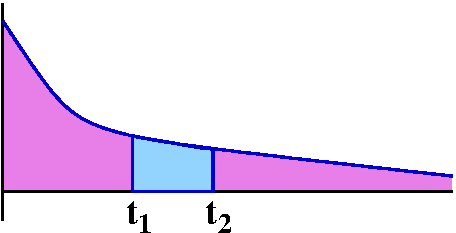
That is, that portion of the area to the right which is shaded
blue represents the chance of a lightbulb burning out during that
particular time interval.
How much work is needed to move Stanley from x=2 to x=1? Realize that
work is still force·distance, but here the force will vary. We
could chop up the interval [1,2] into little pieces of distance,
dx. In a tiny distance the force will be (approximately) constant.
Pushing Stanley that dx distance with magnitude 1/x2 gives
me a (piece of) work 1/x2 dx. The total work will be
the sum of these pieces of work, or  121/x2 dx.
121/x2 dx.
As was pointed out by several students,
there are some silly and probably wrong things here. The force
repels, and I should add work from 2 to 1. So really I should be
computing an integral from 2 to 1 of -1/x2 dx. I think
this is correct. Sigh. There are two minus signs which cancel out and
I get the integral above. For more authentic physical computations,
please see more authentic professors of physics.
I can compute this integral:  121/x2 dx=-1/x]12=-1/2-(-1/1)=1.
121/x2 dx=-1/x]12=-1/2-(-1/1)=1.
But suppose I move Stanley from x=2 to x=a, where a is a small
positive number, so Stanley will be very close to Fred. What's the
work done? We just need a small change in the computation:
 a21/x2 dx=-1/x]a2=-1/2-(-1/a)=1/a-1/2.
a21/x2 dx=-1/x]a2=-1/2-(-1/a)=1/a-1/2.
Suppose I am willing to "expend" any (finite) amount of work. Can I
move Stanley to Fred's position? The answer is "No" because the limit
as a-->0+ of 1/a-1/2 is infinity. Therefore we say that the
improper integral  021/x2 dx diverges. The
integral is improper because the function 1/x2 is certainly
unbounded on its domain. The integral diverges because we would
like to use a limit to define it, and there is no finite value for
this limit.
021/x2 dx diverges. The
integral is improper because the function 1/x2 is certainly
unbounded on its domain. The integral diverges because we would
like to use a limit to define it, and there is no finite value for
this limit.
These integrals, almost "at random", to me are maybe too small to type
into a computer algebra program, even if I am lazy. I think Math 152
students should be able to do these computations by hand.
The h/3 and 1 4 1 pattern are "famous". If you want to see a
proof of this remarkable fact, please look at p.523 of your
textbook. Simpson's rule is gotten by interpolating triples of points
furnished by the function y=f(x).
Please try some of the problems in the textbook. I got the numbers
above using Maple. For example, here is how to create one of the entries in the table:
The textbook presents the partial fraction representation as an
integration strategy. It is certainly such a strategy, because once
the rational function is written in its partial fraction
representation, antidifferentiation is straightforward. So I will
discuss antidifferentiating the pieces, also. But there are practical
reasons one might want the rational functions decomposed. I mentioned
in class that the repulsive force between two classical charged
objects (electrons?) is rational (inverse square). You could
imagine that there's a complicated force law which is rational and has
singularities (where the bottom of the rational function is 0 and the
top is not). I might want to write this as a sum of different forces
each with singularities in only one location. That is always possible
and is a consequence of the partial fraction representation.
Most of the protocols which guarantee privacy and security in web
transactions rely, ultimately, on the difficulty of factoring, even
the difficulty of finding the prime factors of positive integers. The
most well-known algorithm (RSA, for Rivest-Shamir-Adelman) is based on
the following problem: suppose you know that a positive integer is the
product of two primes. What are the primes? Well, 6 is 2 times 3, so
... except that the numbers are hundreds of decimal digits long, and
there is no known feasible way of finding the integer factors. In the
case of polynomials, the problems are, if anything, even more
difficult, as you will see. The types of factors can vary.
Another way of finding A and B so that 11x+7=A(x+1)+B(x-3) is to
"expand" the right-hand side, getting Ax+A+Bx-3B=(A+B)x+(A-3B). Then
we can look at the coefficients of x and the constant term (the
coefficient of x0) to getr
11=A+B
7=A-3B
This is a system of two linear equations in two unknowns and
there are many ways to solve such things. (Hey: A=10 and B=1 are the
solutions of this system!)
Another strategy
Look at the x2 coefficient on both sides of the equation
11x+7=A(x+1)2+B(x-3)(x+1)+C(x-3).
On the left there are no x2's, so the result is 0. On the
right (be careful!) there are A x2's and also B
x2's (there aren't any from the C term). Therefore 0=A+B
and since A is 5/2, B is -5/2.
Thank goodness these are the same. No one was watching
and checking me. I needed three tries to get everything to work out
correctly!
The pieces are:
5/2 -5/2 1
--- + ---- + -----
x-3 x+1 (x+1)2
Can we integrate the result? Yes. The first piece gives 5/2ln(x-3) and the second piece gives -5/2ln(x+1). The last part is (x+1)-2 which gives (-1)(x+1)-1.
If (x-root)multiplicity is a factor of the bottom, then in
Step 2 there will be a bunch of parts,
(various constants)/(x-root)integer, with the integer
going from 1 to multiplicity. For example, the Step 2 response to the following:
x^4-3x^2+5x-7 A B C D E F
------------- = ----- + ----- + ----- + ----- + ----- + -----
(x+5)2(x-7)4 x+5 (x+5)2 x-7 (x-7)2 (x-7)3 (x-7)4
And this would lead to a system of 6 linear equations in 6
unknowns. By the way, Step 3, solving the linear equations,
turns out to be computationally quite straightforward. Here I don't
mean doing things by hand, but on a machine. Very big sytems (tens of
thousands of linear equations) are solved efficiently on computers
frequently.
Yet another example
Well, there is one more wrinkle. Consider the rational function
11x+7
-------------
x3+2x2-2x-12
We need to factor x3+2x2-2x-12. As a hint, I
mentioned that if x=2, then
23+2·22-2(2)+12=8+8-4-12=0. You may
remember from high school that if x=2 is a root of
x3+2x2-2x-12=0, then x-2 is a factor
x3+2x2-2x+12. So:
x2+4x+6
---------------
x-2 | x3+2x2-2x-12
x3-2x2
------------
4x2-2x-12
4x2-8x
-------------
6x-12
6x-12
-----
0
So the quotient is x2+4x+6 and the remainder is 0.
Therefore
x3+2x2-2x-12=(x-2)(x2+4x+6). What are
the roots of x2+4x+6? The quadratic formula indicates that
the discriminant, here 42-4·1·6, is
important. The discriminant is -10. The roots are complex!
In Math 152 we are supposed to deal only with real numbers. Therefore
x2+4x+6 can't be factored any further. This sort of
polynomial is called an irreducible quadratic.
ADVERTISEMENT ADVERTISEMENT ADVERTISEMENT
Yes, COMPLEX NUMBERS are much
easier
to work with than real numbers!
ADVERTISEMENT ADVERTISEMENT ADVERTISEMENT
Partial fractions, back to Step 2 and Step 3
Here is how to handle an irreducible quadratic in a slightly simpler
case. I'll show you the symbolic pieces, and then solve for them.
11x+7 A Bx+C
----------- = ----- + ------
(x-3)(x2+1) x-3 x2+1
So when there is an irreducible quadratic then an unknown
linear term needs to be put on top.
If we combine terms and look at the tops, the result is
11x+7=A(x2+1)+(Bx+C)(x-3).
Again, any method that gets the answer is a good method. So:
x=3 gives 11·3+7=A(32+1)+(Bx+C)0 so 40=10A so A=4.
x=0 gives 7=A(1)+(B·0+C)(-3) so 7=A-3C so since A=4, 7=4-3C and
C=-1.
Consider the x2 coefficients: 0=A+B, so since A=4, B=-1.
Therefore
11x+7 4 -4x-1
----------- = ----- + ------
(x-3)(x2+1) x-3 x2+1
QotD
Integrate this stuff. I remarked that if students found there were
working hard on this, probably they were doing it wrong. As a hint, a
small rewriting:
11x+7 4 -4x -1
----------- = ----- + ------ + -----
(x-3)(x2+1) x-3 x2+1 x2+1
As answer, I expected 4ln(x-3) and -arctan(x) for the first and third
terms. The middle term can be done with u=x2+1 so
du=2x dx, with the result -2ln(u)=-2ln(x2+1). And +C
of course.
| Monday,
February 5 | (Lecture #6) |
|---|
 Finding eagles
Finding eagles
As I mentioned, I had a happy Saturday hiking around a reservoir about
35 miles away. I saw a bald eagle, and was excited (a huge bird, with wing span is 6 to
7 feet). The area was
beautiful, and did not look like a state with a population density
>1,100 people per square mile. Here
is more information about eagles in New Jersey.
The tools for today
The alert student will see that there is an extra "functional
equation". You will soon see why. Also I will exchange the previous
variable, x, for a new variable,  , which your text prefers here.
, which your text prefers here.
|
Derivative formulas |
Functional equations |
|---|
d
--- sin( ) = cos( ) = cos( )
d )
d
d
--- cos( ) = -sin( ) = -sin( )
d )
d
d
--- sec( ) = sec( ) = sec( )tan( )tan( )
d )
d
d
--- tan( ) = (sec( ) = (sec( ))2
d ))2
d
|
1=(cos( ))2+(sin( ))2+(sin( ))2 ))2
cos(2 )=(cos( )=(cos( ))2-(sin( ))2-(sin( ))2 ))2
sin(2 )=2sin( )=2sin( )cos( )cos( ) )
(sec( ))2=(tan( ))2=(tan( ))2+1 ))2+1
(tan( ))2=(sec( ))2=(sec( ))2-1 ))2-1 |
Area of part of a circle
I continued with the example introduced at the end of the previous
lecture.
 01/2sqrt(1-x2)dx.
01/2sqrt(1-x2)dx.
If I want to use FTC to compute this, I should find an antiderivative
for sqrt(1-x2). Last time I tried to motivate the
following substitution: x=sin( ). Then dx=cos(
). Then dx=cos( )d
)d and
sqrt(1-x2)=sqrt(1-sin(
and
sqrt(1-x2)=sqrt(1-sin( )2)=sqrt(cos(
)2)=sqrt(cos( )2)=cos(
)2)=cos( ). Therefore:
). Therefore:
 sqrt(1-x2)dx=
sqrt(1-x2)dx= [cos(
[cos( )]2d
)]2d .
.
We use the double angle formula from the toolbox:
 [cos(
[cos( )]2d
)]2d =
= (1/2)[1+cos(2
(1/2)[1+cos(2 )]d
)]d =(1/2)[
=(1/2)[ +(1/2)sin(2
+(1/2)sin(2 )]+C
)]+C
The extra 1/2 comes from the Chain Rule worked backwards on the
"inside" part of cos(2 ). Now I'd like to return to x-land by
writing everything in terms of x instead of
). Now I'd like to return to x-land by
writing everything in terms of x instead of  . Since
sin(
. Since
sin( )=x, we know that arcsin(x)=
)=x, we know that arcsin(x)= . That allows us to
translate the first part of the answer back to x's. But what about
sin(2
. That allows us to
translate the first part of the answer back to x's. But what about
sin(2 )? Here is where I need the new formula in the toolbox:
sin(2
)? Here is where I need the new formula in the toolbox:
sin(2 )=2sin(
)=2sin( )cos(
)cos( ). Each of these I already know in
terms of x's because x=sin(
). Each of these I already know in
terms of x's because x=sin( ) and cos(
) and cos( ) is above (look!): it
is sqrt(1-x2). And we have a formula:
) is above (look!): it
is sqrt(1-x2). And we have a formula:
 sqrt(1-x2)dx=(1/2)[arcsin(x)+x sqrt(1-x2)]+C.
sqrt(1-x2)dx=(1/2)[arcsin(x)+x sqrt(1-x2)]+C.
There is cancellation of one of the (1/2)'s with the 2 coming from
sine's double angle formula.
We are not yet done, since we asked for a definite integral.
 01/2sqrt(1-x2)dx=(1/2){arcsin(x)+x sqrt(1-x2)}]01/2.
01/2sqrt(1-x2)dx=(1/2){arcsin(x)+x sqrt(1-x2)}]01/2.
Now arcsin(0)=0 and the other term is also 0 at 0, so the lower limit
gives a contribution of 0. The upper limit has
(1/2){arcsin(1/2)+(1/2)sqrt(1-(1/2)2)}. With some thought
we might recall that arcsin(1/2) is Pi/6, and also "compute" that
sqrt(1-(1/2)2)=sqrt(3)/2. Therefore the definite integral
is
(1/2)(Pi/6)+(1/2)(1/2)(sqrt(3)/2).
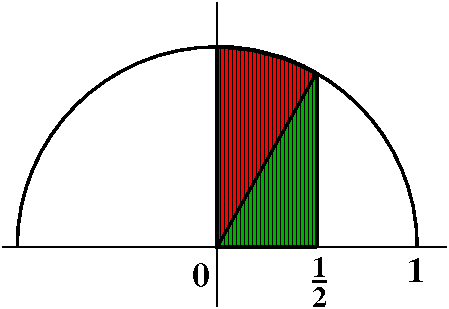 Geometric solution
Geometric solution
Actually you can "see" these numbers in the picture.
The triangle has a base whose length is 1/2. Since
the formula for the upper semicircle is y=sqrt(1-x2), the
height of the triangle is sqrt(3)/2. The area of the triangle must
then be (1/2)(1/2)(sqrt(3)/2).
The base acute angle of the triangle is Pi/3, so the
circular sector has inside angle Pi/6. The area of a circular sector
is (1/2)(angle {in radians!)radius2. Since the radius here
is 1, the area of the circular sector is (1/2)(Pi/6).
Maple's version
First the indefinite integral, and then the definite integral.
> int(sqrt(1-x^2),x);
2 1/2
x (1 - x )
------------- + 1/2 arcsin(x)
2
> int(sqrt(1-x^2),x=0..1/2);
1/2
3 Pi
---- + ----
8 12
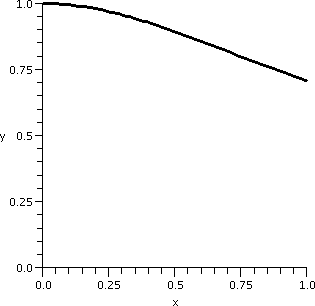
Area under another curve
I want to compute  011/sqrt(1+x2)dx. The value of
this integral is the area under y=sqrt(1+x2)dx between 0
and 1. A picture of this area is shown to the right. The curve has
height 1 at x=0, and then decreases to height sqrt(1/2) at x=1. Since
sqrt(1/2) is about .7, I know that the definite integral, always
between (Max. value)·(Interval length) and
(Min. value)·(Interval length), is between 1 and
.7.
011/sqrt(1+x2)dx. The value of
this integral is the area under y=sqrt(1+x2)dx between 0
and 1. A picture of this area is shown to the right. The curve has
height 1 at x=0, and then decreases to height sqrt(1/2) at x=1. Since
sqrt(1/2) is about .7, I know that the definite integral, always
between (Max. value)·(Interval length) and
(Min. value)·(Interval length), is between 1 and
.7.
It is always nice to know some size estimate of things to be
computed. That gives us at least a rough way of checking on the
methods and the result.
How to do it
Look in the toolbox and see
(sec( ))2=(tan(
))2=(tan( ))2+1. If I look at
sqrt(x2+1) then I think of trying x=tan(
))2+1. If I look at
sqrt(x2+1) then I think of trying x=tan( ), so
dx=[sec(
), so
dx=[sec( )]2 and sec(
)]2 and sec( )=srqt(x2+1).
Then
)=srqt(x2+1).
Then
 1/sqrt(1+x2)dx becomes
1/sqrt(1+x2)dx becomes
 [1/sec(
[1/sec( )][sec(
)][sec( )]2d
)]2d which is
which is
 sec(
sec( ) d
) d . We officially know this integral
because of the ludicrous computation done
earlier. Its value is ln(sec(
. We officially know this integral
because of the ludicrous computation done
earlier. Its value is ln(sec( )+tan(
)+tan( ))+C. We can get back to
x-land using what we already know, so the antiderivative we need is
ln(sqrt(x^2+1)+x)+C.
))+C. We can get back to
x-land using what we already know, so the antiderivative we need is
ln(sqrt(x^2+1)+x)+C.
The definite integral computation then becomes:
ln(sqrt(x^2+1)+x)]01=ln(sqrt(2)+1)+ln(1+0)=ln(sqrt(2)+1)
since ln(1)=0. And ln(sqrt(2)+1) is about .88137, certainly between .7
and 1.
Maple's version
You may ask for an antiderivative. Look at the result, which is
slightly surprising:
> int(1/sqrt(x^2+1),x);
arcsinh(x)
What is this? The function called
"arcsinh" is an inverse function to one of the hyperbolic
functions. The hyperbolic functions are discussed in section 3.9 of
the text. They are frequently just as interesting and relevant to
describing and solving problems as the more commonly used trig
functions. The theory is totally parallel. The trig functions are
connected to the circle, x2+y2=1. The hyperbolic
functions are connected to -x2+y2=1 or
y2=1+x2. There is a Maple instruction which "translates" the
inverse hyperbolic function into things we are supposed to
understand. Here it is:> convert(arcsinh(x),ln);
2 1/2
ln(x + (x + 1) )
The definite integral is recogizable, except for a use of
-ln(A)=ln(1/A) where A=sqrt(2)-1. (You can check that 1/[sqrt(2)-1] is
the same as sqrt(2)+1!) The next instruction finds an approximate
numerical value of the previous answer.> int(1/sqrt(x^2+1),x=0..1);
1/2
-ln(2 - 1)
> evalf(%);
0.8813735879
A third definite integral
I wanted to evaluate  01[sqrt(x2-1)/x3]dx. Because
I see sqrt(x2-1) and the toolbox contains the equation
(tan(
01[sqrt(x2-1)/x3]dx. Because
I see sqrt(x2-1) and the toolbox contains the equation
(tan( ))2=(sec(
))2=(sec( ))2-1 I will "guess" at
the substitution x=sec(
))2-1 I will "guess" at
the substitution x=sec( ), which gives
dx=sec(
), which gives
dx=sec( )tan(
)tan( )d
)d and
sqrt(x2-1)=tan(
and
sqrt(x2-1)=tan( ). With this know, I can rewrite the
integral.
). With this know, I can rewrite the
integral.
 [sqrt(x2-1)/x3]dx becomes
[sqrt(x2-1)/x3]dx becomes  [tan(
[tan( )/sec(
)/sec( )3]sec(
)3]sec( )tan(
)tan( )d
)d .
Then cancel everything you can. The result is
.
Then cancel everything you can. The result is  [cos(
[cos( )]2d
)]2d . We
already considered this integral, The key observation was:
. We
already considered this integral, The key observation was:
(cos(x))2
can be replaced by (1/2)(1+cos(2x)): the degree is halved, but the
function gets more complicated.
so
 [cos(
[cos( )]2d
)]2d =
=
 (1/2)[1+cos(2
(1/2)[1+cos(2 )]d
)]d =(1/2)[
=(1/2)[ +(1/2)sin(2
+(1/2)sin(2 )}+C=(1/2)[
)}+C=(1/2)[ +sin(
+sin( )cos(
)cos( )]+C
using the double angle formula for sine, also in today's toolbox.
)]+C
using the double angle formula for sine, also in today's toolbox.
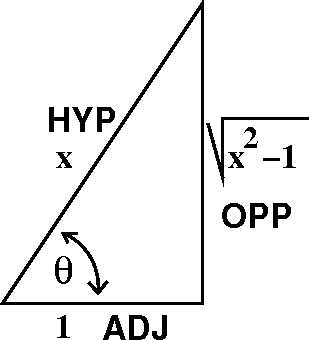 Back to x-land
The translation back turns out to be interesting and more involved
than similar previous transactions. We know that sec(
Back to x-land
The translation back turns out to be interesting and more involved
than similar previous transactions. We know that sec( )=x and we
want to know what sine and cosine of
)=x and we
want to know what sine and cosine of  are in terms of x. One way
some people use is drawing a right triangle with one acute angle equal
to
are in terms of x. One way
some people use is drawing a right triangle with one acute angle equal
to  , and with sides selected so that sec(
, and with sides selected so that sec( ) is x. Since (with
some effort) we know that secant is ADJACENT/HYPOTENUSE, and we can
think that x is x/1, well the triangle must be like what is
pictured. Then Pythagoras allows us to get the oppositite side, as the
square root of the difference of the squares of the hypotenuse and the
adjacent side. From the triangle we can read off
sin(
) is x. Since (with
some effort) we know that secant is ADJACENT/HYPOTENUSE, and we can
think that x is x/1, well the triangle must be like what is
pictured. Then Pythagoras allows us to get the oppositite side, as the
square root of the difference of the squares of the hypotenuse and the
adjacent side. From the triangle we can read off
sin( )=sqrt(x2-1)/x and cos(
)=sqrt(x2-1)/x and cos( )=1/x. Then
(1/2)[
)=1/x. Then
(1/2)[ +sin(
+sin( )cos(
)cos( )]+C becomes
(1/2)[arcsec(x)+sqrt(x2-1)/x2]+C. As I explained
in class, arcsec is a fairly loathsome function (yes, this is a
value judgement about a morally neutral function). In fact,
when I asked my silicon friend, the reply was the following:
)]+C becomes
(1/2)[arcsec(x)+sqrt(x2-1)/x2]+C. As I explained
in class, arcsec is a fairly loathsome function (yes, this is a
value judgement about a morally neutral function). In fact,
when I asked my silicon friend, the reply was the following:
> int(sqrt(x^2-1)/x^3,x);
2 3/2 2 1/2
(x - 1) (x - 1) 1
----------- - ----------- - 1/2 arctan(-----------)
2 2 2 1/2
2 x (x
- 1)
That is, Maple does not want to deal
with arcsec at all. Yes, if you really wish, there is a
convert instruction to get the arcsec version. With some
effort, you can look at the triangle and see what arcsec is using
arctan.
Are we stupid?
We're really not done with the problem. I asked for a definite
integral. Here is what happened to that inquiry on a machine:
> int(sqrt(x^2-1)/x^3,x=0..1);
infinity I
I wanted to do this specifically to show you the result. The machine
will do (try to do?) what you ask. This is a sort of silly answer, but
the question is, indeed, sort of ridiculous. The integrand is
[sqrt(x2-1)/x3]. On the interval [0,1], the
bottom has x3. I bet that as x-->0+, something
weird may happen: the integrand gets very, very large. That explains
the infinity in the result. Later in the course we will see how to
assign certain integrals finite values even when bad things happen to
the integrand, but that procedure won't apply in this case. Where does
the I come from? Well, look at x's inside [0,1]. Those x's make
x2-1 negative and the integrand is requesting the
square root of a negative number. Although we are not supposed to
discuss complex numbers in this course, the machine believes we want a
complex number computation, and it emits (?) an I to indicate this.
So a silly question gets an appropriately silly answer.
A final integral with a square root
The last antiderivative of this type I looked at was something like:
 sqrt(x2+6x+7)dx.
Here
the novelty is the 4x term. Some algebra which you have likely seen
before can be used to change this to a form we can handle.
sqrt(x2+6x+7)dx.
Here
the novelty is the 4x term. Some algebra which you have likely seen
before can be used to change this to a form we can handle.
Getting rid of the x term
We are "motivated" by the expansion:
(x+A)2=x2+2Ax+A2. We will
complete the square. So:
x2+6x+7=x2+2(3x)+7=x2+2(3x)+32-32+7=(x+3)2-9+7=(x+3)2-2.
Now make the substitution u=x+3 with du=dx. Then
 sqrt(x2+6x+7)dx
becomes
sqrt(x2+6x+7)dx
becomes
 sqrt(u2-2)dt. We can
sort of handle this with a trig substition but there is -2 instead of
-1.
sqrt(u2-2)dt. We can
sort of handle this with a trig substition but there is -2 instead of
-1.
Start with (tan( ))2=(sec(
))2=(sec( ))2-1 and
multiply by 2 to get
2(tan(
))2-1 and
multiply by 2 to get
2(tan( ))2=2(sec(
))2=2(sec( ))2-2. I "guess" that
I would like to try t=sqrt(2)sec(
))2-2. I "guess" that
I would like to try t=sqrt(2)sec( ). Then
t2=2(sec(
). Then
t2=2(sec( ))2, so t2-2 is
2(tan(
))2, so t2-2 is
2(tan( ))2. Also
dt=sqrt(2)sec(
))2. Also
dt=sqrt(2)sec( )tan(
)tan( ) d
) d . The integral in
. The integral in  -land
is
-land
is  sqrt[2(tan(
sqrt[2(tan( ))2]sqrt(2)sec(
))2]sqrt(2)sec( )tan(
)tan( ) d
) d which is
which is
 2sec(
2sec( )[tan(
)[tan( )]2d
)]2d . As I said in class,
I got bored here. The previous methods can handle this. The details
are complicated and offer lots of opportunity for error. Look below
for a final answer.
. As I said in class,
I got bored here. The previous methods can handle this. The details
are complicated and offer lots of opportunity for error. Look below
for a final answer.
Etc.
> int(sqrt(x^2+6*x+7),x);
2 1/2
(2 x + 6) (x + 6 x + 7) 2 1/2
--------------------------- - ln(x + 3 + (x + 6 x + 7) )
4
Really really simple algebra
From eighth grade we know:
3 7 3(x+5)+7(x+2) 10x+29
--- + --- = ------------- = ----------
x+2 x+5 (x+2)(x+5) x2+7x+10
Therefore we can write:  [10x+29/x2+7x+10]dx=3ln(x+2)+7ln(x+5)+C. This
antidifferentiation is maybe not obvious. So let me try something a
bit more adventurous.
[10x+29/x2+7x+10]dx=3ln(x+2)+7ln(x+5)+C. This
antidifferentiation is maybe not obvious. So let me try something a
bit more adventurous.
An antiderivative
Can we find an antiderivative of [5x-7/x2-2x-3]? We can try
to imitate what was just done ("reverse engineering"). Surely
x2-2x-3=(x-3)(x+1). And if we want to write:
5x-7 A B A(x+1)+B(x-3)
---------- = ----- + ----- = -------------
(x-3)(x+1) x-3 x+1 (x-3)(x+1)
then 5x-7 should be the same as A(x+1)+B(x-3). Well, if
5x-7=A(x+1)+B(x-3), then, for example, if x=-1, I know that
5(-1)-7=A(0)+B(-1-3) or -12=-4B and B=3.
QotD
What is the value of A (my suggestion: use another magic number for
x)? After A is found, write down (very little computation should be
required!) a formula for  [5x-7/x2-2x-3]dx.
[5x-7/x2-2x-3]dx.
| Wednesday,
January 31 | (Lecture #5) |
|---|
I remarked the following (after reading through the previous QotD
answers!):
The derivative of ln x is 1/x.
The integral of ln x is [I asked
students to send me e-mail about this and offered .1 bonus point on
the final exam for any correct answers.]
Here is one message I received:The integral of ln(x) dx is x*ln(x) - x + C
First, let u = ln(x), dv = dx, du = 1/x dx, and v = x. Then by
integrating by parts, the integral of ln(x) dx = x*ln(x) - the
integral of x*(1/x) dx. The integral of x*(1/x) dx equals x, so the
answer is x*ln(x) - x + C.
-Bo Hye S. Lee
Section 05
So the integral of ln x is
x ln x-x+C.
I thank
Bo Hye S. Lee
and
Michael Yang
and
Alex C. Scheller and
Joe Corry and
Glenn Davis and
Kenneth Kong and
Erica Choi and
Abisola Oluwo and
Kyle K. Vu for their wonderful work. They all responded with
the correct answer. All will get ... whatever.
The clinic this Sunday will be held from 2
to 5 PM (in the afternoon). I strongly urge you to attend and
do some problems. The "facilitator" has great experience helping
students and is good at it (probably better than I am, darn it!). The
course material is rapidly getting denser (!) and practice
is really useful.
I mentioned that, according to the local
rules, students could get a quiz tomorrow (in their
recitations). I then had a remarkable twitch in my right eye (which,
interestingly enough, was taken apart last year [really] in a
remarkable operation).
Today I will slip behind the
official syllabus, because I just think we need more time. I will
do one more integration by parts, an amazing result, and then start
what's in 7.2. The official syllabus has me also covering 7.3, but I
will merely hint at what's in 7.3.
General topic: integrals of powers of trig functions
The easier one: sines and cosines
I want to describe how to find  (sin(x))A(cos(x))Bdx if A and B are
non-negative integers. So I will concentrate of how to do this by
hand. You need to know this for exams in Math 152. If I were
describing a method to be implemented by a program, I'd say other
things (more below). y intention is to concentrate on moderately
efficient methods for relatively small A and B.
(sin(x))A(cos(x))Bdx if A and B are
non-negative integers. So I will concentrate of how to do this by
hand. You need to know this for exams in Math 152. If I were
describing a method to be implemented by a program, I'd say other
things (more below). y intention is to concentrate on moderately
efficient methods for relatively small A and B.
What's needed
Sine &
Cosine
Tools |
d
--- sin(x) = cos(x)
dx |
1=(cos(x))2+(sin(x))2 |
|---|
| d
--- cos(x) = -sin(x)
dx | cos(2x)=(cos(x))2-(sin(x))2 |
Odds
If either A or B is odd things are easy. I will do an example with A=4 and B=5:
 (sin(x))4(cos(x))5dx.
(sin(x))4(cos(x))5dx.
I don't remember if this is exactly what I did in class. Here "borrow"
one of the cosine's to live with the dx: cos(x) dx. This suggests
to me that I can use u=sin(x) so du=cos(x)dx. Now (sin(x))4
becomes u4. But we also have (cos(x))4 to change
into u's. Remember (the tools above) that
(cos(x))2=1-(sin(x))2. We need to be careful
about exponents, but
(cos(x))4=((cos(x))2)2=(1-(sin(x))2)=(1-u2)2
Therefore with u=sin(x), the integral changes
 (sin(x))4(cos(x))5dx=
(sin(x))4(cos(x))5dx= u4(1-u2)2du.
u4(1-u2)2du.
We have changed an integral involving powers of sine and cosine into
an integral which is just a polynomial. We can expand the square,
multiply, integrate, and then change back to x's:
 u4(1-u2)2du=
u4(1-u2)2du= u4(1-2u2+u4)du=
u4(1-2u2+u4)du= u4-2u6+u8du=(1/5)u5-(2/7)u7+(1/9)u9+C=(1/5)(sin(x))5-(2/7)(sin(x))7+(1/9)(sin(x))9+C
u4-2u6+u8du=(1/5)u5-(2/7)u7+(1/9)u9+C=(1/5)(sin(x))5-(2/7)(sin(x))7+(1/9)(sin(x))9+C
This is the easy case!
Evens
In one lecture I did a sane example, and in the other lecture, the one
I did was rather poorly chosen (too darn elaborate!). But if I had to
do one of these integrals "by hand" with both
A and B even I would try the strategy shown in the example below. I'll do A=4
and B=0 here (they are both non-negative even integers):
 (sin(x))4dx.
(sin(x))4dx.
I can't just borrow one of the sine's to create a u as we
did before. The result will not give me a simple polynomial to
integrate -- I'll have some mess with square roots in it, and things
will just be complicated. Here is what I would do. This is a trick
which sort of halves the power, but at the expense of making other
things more complicated.
Let's consider (sin(x))4. It is, of course, ((sin(x))2)2. The trick is to use the other column of
the tools in an appropriate way. Well, we can
subtract the equations. Take a look:
1 = (cos(x))2+(sin(x))2
-
cos(2x) = (cos(x))2-(sin(x))2
1-cos(2x) = 2(sin(x))2Therefore (sin(x))2
becomes (1/2)(1-cos(2x)) and
(sin(x))4 becomes
{(1/2)(1-cos(2x))}2
and this can be multiplied out to get
(1/4){1-2cos(2x)+(cos(2x))2}.
Now what? We still have (cos(2x))2. We need a version of
the same trick, but dealing with a cosine squared term. Again
consider
the second column of the tools. We can add
the equations. The (sin(x))2 will cancel, and there will be
two (cos(x))2. That is:
1 = (cos(x))2+(sin(x))2
+
cos(2x) = (cos(x))2-(sin(x))2
1+cos(2x) = 2(cos(x))2Therefore (cos(x))2
can be replaced by (1/2)(1+cos(2x)): the degree is halved, but the
function gets more complicated.
But we need to deal with (cos(2x))2. So the change the equation
(cos(x))2=(1/2)(1+cos(2x)) by substituting 2x for x everywhere.
Then we have (cos(2x))2=(1/2)(1+cos(4x)).
(1/4){1-2cos(2x)+(cos(2x))2} becomes
(1/4){1-2cos(2x)+(1/2)(1+cos(4x)}=(1/4)-(1/2)cos(2x)+(1/8)+(1/8)cos(4x).
Remember that the goal of all this is to get something that we can
antidifferentiate, and, finally, we can with do that here. The
antiderivative is almost easy, if we remember that the chain rule
makes dividing by the multiplier of the x necessary. So the antiderivative is
(1/4)x-(1/4)sin(2x)+(1/8)x+(1/32)sin(4x)+C.
Maple results compared to those just obtained
So I asked Maple to find the
antiderivatives. Below are the responses, together with what I got.
| Function | Maple's
antiderivative | What I got |
|---|
| (sin(x))4(cos(x))5 | -(1/9)(sin(x))3(cos(x))6-(1/21)sin(x)(cos(x))6
+(1/105)(cos(x))4sin(x)+(4/315)(cos(x))2sin(x)
+(8/315)sin(x) | (1/5)(sin(x))5-(2/7)(sin(x))7+(1/9)(sin(x))9+C |
| (sin(x)) | -(1/4)(sin(x))3cos(x)-(3/8)cos(x)sin(x)+(3/8)x | (1/4)x-(1/4)sin(2x)+(1/8)x+(1/32)sin(4x)+C. |
It turns out that these actually are exactly the same
functions. You can graph them and the results "overlay" one
another. The algebraic differences can be irritating.
Warning!
Sometimes the functions you get can actually be different. Let me show
you a very artificial but simple example. How can we find an
antiderivative of x(x+1)? Well, a sane human being would multiply and
get x2+x and then integrate to get
(1/3)x3+(1/2)x2 (+C). A crazy person could do the following: integrate by parts. So:
 x (x+1)dx=(1/2)x(x+1)2-
x (x+1)dx=(1/2)x(x+1)2- (1/2)(x+1)2dx=(1/2)x(x+1)2-(1/6)(x+1)3.
udv = uv - vdu
u=x du=dx
dv=(x+1)dx v=(1/2)(x+1)2
(1/2)(x+1)2dx=(1/2)x(x+1)2-(1/6)(x+1)3.
udv = uv - vdu
u=x du=dx
dv=(x+1)dx v=(1/2)(x+1)2
Therefore (1/3)x3+(1/2)x2 and
(1/2)x(x+1)2-(1/6)(x+1)3 must both be antiderivatives of x(x+1).
Please notice that the first answer has value 0 when x=0 and the second answer has value -1/6
when x=0, so these are distinct functions! Is there a problem? Actually, no. Here theory
(if you remember MVT) says you can have infinitely many (not just 2!) distinct
antiderivatives of one function, provided they differ by a constant. And, indeed, the algebra says:
(1/2)x(x+1)2-(1/6)(x+1)3=
(1/2)x(x2+2x+1)-(1/6)(x3+3x2+3x+1)=
(1/2)x3+x2+(1/2)x-(1/6)x3-(1/2)x2-(1/2)x-(1/6)=
(1/3)x3-(1/2)x2-(1/6)
The two graphs are parallel to each other. Of course this example is
maybe quite silly, but if you use computer algebra systems, you've
always got to remember that "different" answers can both be valid! A
computer program can't always be relied on to give sensible (?)
answers.
Reduction formula
Here is probably what Maple uses on powers of sine, say.
Since
 (sin(x))ndx=
(sin(x))ndx=
 (sin(x))n-1 cos(x)dx we can do this:
(sin(x))n-1 cos(x)dx we can do this:
 (sin(x))n-1 cos(x)dx=(sin(x))n-1{-cos(x)}-(n-1)
(sin(x))n-1 cos(x)dx=(sin(x))n-1{-cos(x)}-(n-1) (-cos(x))(sin(x))n-2cos(x)dx
udv = uv - vdu
u=(sin(x))n-1 du=(n-1)(sin(x))n-2cos(x)dx
dv=sin(x)dx v=-cos(x)
(-cos(x))(sin(x))n-2cos(x)dx
udv = uv - vdu
u=(sin(x))n-1 du=(n-1)(sin(x))n-2cos(x)dx
dv=sin(x)dx v=-cos(x)
But the integral you get "out" is
=(sin(x))n-1{-sin(x)}-(n-1) (sin(x))n-2(cos(x))2dx) and since (cos(x))2 is the same as 1-(sin(x))2, you can "solve" for the original integral. This does work. I think the result is:
(sin(x))n-2(cos(x))2dx) and since (cos(x))2 is the same as 1-(sin(x))2, you can "solve" for the original integral. This does work. I think the result is:
 (sin(x))ndx=
(1/n)(sin(x))n-1{-cos(x)}+[(n-1)/n]
(sin(x))ndx=
(1/n)(sin(x))n-1{-cos(x)}+[(n-1)/n] (sin(x))n-2dx
(sin(x))n-2dx
I wouldn't use this strategy by hand, but it is lovely for a program.
Now secants and tangents
I want to describe how to find  (sec(x))A(tan(x))Bdx if A and B are
non-negative integers. So I will concentrate of how to do this by
hand. You need to know this for exams in Math 152. Again, if I were
describing a method to be implemented by a program, I'd say other
things. Here I will definitely only look at
small A and B because things get very messy rapidly.
(sec(x))A(tan(x))Bdx if A and B are
non-negative integers. So I will concentrate of how to do this by
hand. You need to know this for exams in Math 152. Again, if I were
describing a method to be implemented by a program, I'd say other
things. Here I will definitely only look at
small A and B because things get very messy rapidly.
What's needed for these functions
Secant &
Tangent
Tools |
d
--- sec(x) = sec(x)tan(x)
dx |
(sec(x))2=(tan(x))2+1 |
|---|
| d
--- tan(x) = (sec(x))2
dx |
(tan(x))2=(sec(x))2-1 |
Early examples
 (sec(x))2dx=tan(x)+C
(sec(x))2dx=tan(x)+C
 (tan(x))2=
(tan(x))2= (sec(x))2-1 dx
=tan(x)-x+C
(sec(x))2-1 dx
=tan(x)-x+C
I hope that you see even these "low degree" examples have a bit of novelty. Even worse are the first powers!
 tan(x) dx=
tan(x) dx= [sin(x)/cos(x)]dx=
[sin(x)/cos(x)]dx= -(1/u)du=-ln(u)+C=-ln(cos(x))+C=ln(sec(x))+C
-(1/u)du=-ln(u)+C=-ln(cos(x))+C=ln(sec(x))+C
where I rewrote tan(x) as sin(x) over cos(x), and then used the
substitution u=cos(x) with du=-sin(x) dx and then got a log and
then pushed the minus sign inside the log by taking the reciprocal of
the log's contents! Horrible.
Much worse, much much worse, is the following:
- Here is the beginning:
 sec(x) dx
sec(x) dx
- Multiply the top and bottom by sec(x)+tan(x), which doesn't change the value since this is "just" an extremely weird way of writing 1:
 sec(x){[sec(x)+tan(x)]/[sec(x)+tan(x)]}dx
sec(x){[sec(x)+tan(x)]/[sec(x)+tan(x)]}dx
- Rearrange algebraically a little bit:
 {[(sec(x))2+sec(x)tan(x)]/[sec(x)+tan(x)]}dx
{[(sec(x))2+sec(x)tan(x)]/[sec(x)+tan(x)]}dx
- Notice (hah!) that the derivative of sec(x)+tan(x) is
sec(x)tan(x)+(sec(x))2 and that, therefore (hah hah!) if
you take u=sec(x)+tan(x) then du=[sec(x)tan(x)+(sec(x))2]dx
which is exactly the top, so the integral is
 (1/u)du which is ln(u)+C.
(1/u)du which is ln(u)+C.
- And now back to x's: the result is ln(sec(x)+tan(x))+C.
So, clearly ln(sec(x)+tan(x))+C is the integral of sec(x).
This is not at all clear to me. This "computation" is probably the
single most irritating (because of the lack of motivation) in the
whole darn course. The history (I don't have a convenient reference)
of this fact is that it was discovered as a result of the construction
of certain numerical tables used for ocean navigation. This fact is
sort of absurd.
Another example
 (tan(x))4dx=
(tan(x))4dx=
 (tan(x))2(tan(x))2dx=
(tan(x))2(tan(x))2dx=
 (tan(x))2{(sec(x))2-1}dx=
(tan(x))2{(sec(x))2-1}dx=
 (tan(x))2(sec(x))2-(tan(x))2dx=
(1/3)(tan(x))3-(tan(x)-x))+C.
(tan(x))2(sec(x))2-(tan(x))2dx=
(1/3)(tan(x))3-(tan(x)-x))+C.
The first "chunk" came from realizing that
(tan(x))2(sec(x))2 is the derivative of tangent
multiplied by tangent squared, and so a substitution u=tan(x) changes
this to u2 and the result is (1/3)u3 (and then
back to x). The second part comes from the previous integral of
(sec(x))2.
And another
NO, no ... I'm getting tired. You try some, and do the homework.
The ideas
All of the algebraic work is to get these trig powers to somehow
change to polynomials or other very simple functions. But:
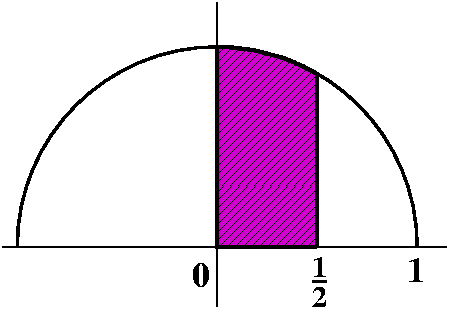 Why look at these things?
Why look at these things?
Look at the upper half of the unit circle in the plane. This is the
graph of y=sqrt(1-x2). Suppose we want to find the area
"under" this curve from 0 to 1/2. This is not a horribly complicated
desire. Then we would need to compute  01/2sqrt(1-x2) dx. Nothing
in this course so far allows us to use FTC here. We need to find an
antiderivate of sqrt(1-x2). Well, the "natural" this is to
look for a substitution. Well, let's try to guess a substitution which
will interact well with the square root. If x=? then let's call
sqrt(1-?2)=!. I don't like square roots, so let's square
this: 1-?2=!2. I don't like minus signs, so let
me get rid of that one:
01/2sqrt(1-x2) dx. Nothing
in this course so far allows us to use FTC here. We need to find an
antiderivate of sqrt(1-x2). Well, the "natural" this is to
look for a substitution. Well, let's try to guess a substitution which
will interact well with the square root. If x=? then let's call
sqrt(1-?2)=!. I don't like square roots, so let's square
this: 1-?2=!2. I don't like minus signs, so let
me get rid of that one:
1=?2+!2
If we knew a nice pair of functions whose squares add up to 1, then
they would be natural candidates for ? and !. Indeed, we do know such
functions. I'll finish this example next time.
QotD
What is  (sin(x))2(cos(x))3dx?
(sin(x))2(cos(x))3dx?
| Monday, January
29 | (Lecture
#4) |
|---|
Maintenance ...
- Workshops I graded two sections of the first
workshop. The grades I gave ranged from 0 to 10 (more 10's than 0's,
though). Students got 10's who gave good explanations of the
computations and then provided evidence of the computations. Earning a
10 did not mean that a long essay was written. 10 points could
certainly be earned with one page handed in. Students who provided no
justification or explanation of their work were automatically limited
to 5 points out of 10!
In this week's workshop (pumping out three tanks), I believe the
conclusion of {most|least} work should be almost clear, and students
will need to show their work and support their assertions with clear,
simple sentences.
- QotD The last QotD was supposed to be a straightforward
integration using substitution. I even gave a hint of the
substitution. Students who had trouble with this are already (only 3
lectures in!) way behind. I think that what I discuss today will
emphasize this.
We move today from what I think of as a conceptual part of the
course (definite integrals can be used to think about ... many things
[we'll return to this, though]) to a more computational part of
the course: how to compute definite integrals. Certainly the most
important methods are substitution, which reverses the chain
rule, and integration by parts, which (sort of!) reverses the
product rule. Today's lecture is entirely about integration by parts.
The product rule for derivatives states that if f(x) and g(x) are
differentiable functions, then the product function,
(f·g)(x)=f(x)g(x), is also differentiable, and its derivative
is given by the following:
(f·g)´(x)=f´(x)g(x)+f(x)g´(x).
Let's integrate this equation. But, wait, if we integrate
(f·g)´(x) we'll just get f(x)g(x), the product of the
functions (the integral of a derivative is the original function). So:
f(x)g(x)= f´(x)g(x)dx+
f´(x)g(x)dx+ f(x)g´(x)dx.
f(x)g´(x)dx.
One version of integration by parts occurs if we put the second term
on the right on the other side of the equation, with a minus sign, of
course. So:
 f´(x)g(x)dx=f(x)g(x)-
f´(x)g(x)dx=f(x)g(x)- f(x)g´(x)dx.
f(x)g´(x)dx.
What's above is the total theoretical content of this lecture
(!) and of lots of other lectures. Clever choices of the functions
turn out to be what's important. So let me immediately do
Example 0
Let's compute  x sin(x)dx. I
don't happen to know an antiderivative, so maybe what I will do is try
to fit the "template" of the left-hand side of the equation above:
x sin(x)dx. I
don't happen to know an antiderivative, so maybe what I will do is try
to fit the "template" of the left-hand side of the equation above:
 f´(x)g(x)dx. I will "choose"
f´(x) to be sin(x) and g(x) to be x. Then I know that
g´(x)=1 and f(x)=-cos(x). The whole equation
f´(x)g(x)dx. I will "choose"
f´(x) to be sin(x) and g(x) to be x. Then I know that
g´(x)=1 and f(x)=-cos(x). The whole equation
 f´(x)g(x)dx=f(x)g(x)-
f´(x)g(x)dx=f(x)g(x)- f(x)g´(x)dx
f(x)g´(x)dx
becomes
 x sin(x)dx=x[-cos(x)]-
x sin(x)dx=x[-cos(x)]- [-cos(x)]1 dx.
[-cos(x)]1 dx.
So we have "traded in" the hard (difficult?) integral,  x sin(x)dx, for an easier integral, -
x sin(x)dx, for an easier integral, - [-cos(x)]1 dx, with a "penalty" of x[-cos(x)]. We can compute the easier integral:
[-cos(x)]1 dx, with a "penalty" of x[-cos(x)]. We can compute the easier integral:
 [-cos(x)]1 dx=-sin(x)+C
[-cos(x)]1 dx=-sin(x)+C
and now we package things together and get:
 x sin(x)dx=x[-cos(x)]-[-sin(x)]+C.
x sin(x)dx=x[-cos(x)]-[-sin(x)]+C.
There's several remarks to make. First, we can usually check
integration results quite easily, just by differentiating. So:
d/dx of -x cos(x)+sin(x)+C is -cos(x)+(-x)[-sin(x)]+cos(x)+0.
The derivative of the first term "gives birth" to the first two terms
of the result (using the product rule) and then the derivative of the
second term just happens (no, not at all!) to cancel one of the first
terms, and, of course, the +C differentiates to 0. An alert student
will surely see that we are just doing in reverse what was called
integration by parts, so the verification should not be too
surprising. I won't bother with further verifications because, as you
will see, they tend to be rather tedious.
One rather superficial but irritating aspect of this
computation is that there are many minus signs. You will see, when
using integration by parts, lots and lots and lots of minus
signs. They will be common, and every human being will make errors
handling them. Please don't make too many.
The notation I've shown you is quite clumsy, and almost everyone uses
a more compact way of writing things. Here is the integration by parts
formula, as everyone uses it:
 u dv=uv-
u dv=uv- v du
v du
In order to use this, we will need to complete the information below:
u=______ du=_______
dv=_______ v=______
In what we just did, u=x and dv=cos(x), so du=dx and v=-sin(x)dx.
Let me show some more examples.
Example 1
 x exdx. Here:
x exdx. Here:
 u dv=uv-
u dv=uv- v du
v du
In order to use this, we will need to complete the information below:
u=x du=dx
dv=exdx v=ex
Therefore,  u dv=uv-
u dv=uv- v du becomes
v du becomes
 x exdx=x ex-
x exdx=x ex- exdx=x ex-ex+C.
exdx=x ex-ex+C.
The second integral is easier. Next:
Example 2
 x2 exdx. Here maybe there are more
choices for the formula
x2 exdx. Here maybe there are more
choices for the formula  u dv=uv-
u dv=uv- v du but the idea is
to take a hard integral and ... well, make it easier: maybe not easy,
that's not always possible, but frequently we can make it
easier. Here's some choices:
v du but the idea is
to take a hard integral and ... well, make it easier: maybe not easy,
that's not always possible, but frequently we can make it
easier. Here's some choices:
u=x2 du=2x dx
dv=exdx v=ex
So we get:
 x2 exdx=x2 ex-
x2 exdx=x2 ex- 2x exdx
2x exdx
We need to compute  2x exdx which is 2
2x exdx which is 2 x exdx. My goodness! Example 1 told us that this integral is
x ex-ex, so we can complete the integration:
x exdx. My goodness! Example 1 told us that this integral is
x ex-ex, so we can complete the integration:
 x2 exdx=x2 ex-
x2 exdx=x2 ex- 2x exdx=x2 ex-2[x ex-ex]+C.
2x exdx=x2 ex-2[x ex-ex]+C.
Example 3
 x3 exdx. I bet we can
... well, this is where I began to get bored in class. We could take
u=x3 and dv=exdx and ... there will be a
transition to an easier integral. Or we could be more systematic, and
more symbolic. Here:
x3 exdx. I bet we can
... well, this is where I began to get bored in class. We could take
u=x3 and dv=exdx and ... there will be a
transition to an easier integral. Or we could be more systematic, and
more symbolic. Here:
Example n
Suppose n is a positive integer, and we want to analyze  xn exdx
using integration by parts. Choose parts as follows:
xn exdx
using integration by parts. Choose parts as follows:
u=xn du=nxn-1dx
dv=exdx v=ex
Then  u dv=uv-
u dv=uv- v du becomes
v du becomes
 xnexdx=xnex-n
xnexdx=xnex-n xn-1exdx
xn-1exdx
I pulled the n out of the second integral because there's no x in the
n, so (relative to dx) it is a constant. This sort of formula is
called a reduction formula. Here is how I might use it,
if I had to do the following computation by hand:
 (7x5-3x2+8)exdx=
(7x5-3x2+8)exdx=
I'll first break things up and take out constant multiplies:
-
7
 x5exdx=7(x5ex-5(
x4ex-4x3ex-3(x2ex-2(xex-1(ex
)
)
)
)
))
x5exdx=7(x5ex-5(
x4ex-4x3ex-3(x2ex-2(xex-1(ex
)
)
)
)
))
-
-3
 x2dx=-3(x2ex-2(xex-1(ex)
))
x2dx=-3(x2ex-2(xex-1(ex)
))
- +8
 exdx=8ex
exdx=8ex
And then I would add up everything and, oh yes, put on +C.
I would hope that you will not have to do this sort of thing "by hand". But, as I mentioned in class, you can use it to check the "shape" of the answer. Here are some Maple questions and responses:
> int((7*x^5-3*x^2+8)*exp(x),x);
2 3 4 5
(-838 + 846 x - 423 x + 140 x - 35 x + 7 x ) exp(x)
> int(7*x^5-3*x^2+8*exp(x),x);
6
7 x 3
---- - x + 8 exp(x)
6
The first question and response is the correct one. And, hey, the
answer does have the right shape: it is a polynomial multiplied by
exp(x) (this is ex in this version of Maple notation). But, golly, if I just forgot
the parentheses, look at the difference in the answer. If I knew what
to expect, maybe I could correct my own error more easily.
 Example 17
Example 17
Arctan is an interesting function. It is the inverse to the
tangent function on the interval between -Pi/2 and Pi/2. The domain of
arctan is all numbers, and its range is the open interval between
-Pi/2 and Pi/2. It is always increasing. A picture is shown to the
right. What's the area "under" y=arctan(x) between 0 and 1? This can
be computed if we know about  01arctan(x)dx, so I need an antiderivative of arctan(x). Since
this is the integration by parts lecture, probably (sigh!) we will use
that method. So:
01arctan(x)dx, so I need an antiderivative of arctan(x). Since
this is the integration by parts lecture, probably (sigh!) we will use
that method. So:
 u dv=uv-
u dv=uv- v du and the first integral is
v du and the first integral is  arctan(x)dx.
arctan(x)dx.
There really aren't many choices of parts here. I bet we should choose u=arctan(x). Once this choice is made, all of the others are forced. So dv must be dx, and v=x. We can get du if we remember the derivative of arctan(x). So du=[1/(1+x2)]dx. I mention that after some experience with integration by parts, sometimes you can look ahead and see if the resulting integral is actually "easier". Well, here is the result:
 arctan(x)dx=x arctan(x)-
arctan(x)dx=x arctan(x)- x=[1/(1+x2)]dx.
x=[1/(1+x2)]dx.
What about  x=[1/(1+x2)]dx? If you are familiar with substitutions, then this won't be difficult. Let me use the letter w, since u is already in the parts formula.
x=[1/(1+x2)]dx? If you are familiar with substitutions, then this won't be difficult. Let me use the letter w, since u is already in the parts formula.
To compute  x=[1/(1+x2)]dx, take w=1+x2. Then dw=2x dx, and we only need x dx, so (1/2)dw=x dx. Then:
x=[1/(1+x2)]dx, take w=1+x2. Then dw=2x dx, and we only need x dx, so (1/2)dw=x dx. Then:
 x=[1/(1+x2)]dx=(1/2)
x=[1/(1+x2)]dx=(1/2) (1/w) dw=(1/2)ln(w)+C=(1/2)ln(1+x2)+C.
(1/w) dw=(1/2)ln(w)+C=(1/2)ln(1+x2)+C.
We need to put this back into the previous computation.
 arctan(x)dx=x arctan(x)-(1/2)ln(1+x2)+C. But we wanted a definite integral:
arctan(x)dx=x arctan(x)-(1/2)ln(1+x2)+C. But we wanted a definite integral:
 01arctan(x)dx=x arctan(x)-(1/2)ln(1+x2)]01.
01arctan(x)dx=x arctan(x)-(1/2)ln(1+x2)]01.
 Now when x=0,
0 arctan(0)=0 and ln(1+02)=ln(1)=0. So plugging in 0
gets us 0. Plug in 1: arctan(1)-(1/2)ln(2). Now arctan(1) can be given
in terms of tranditional constants, and it is Pi/4. And actually,
(1/2)ln(2)=ln(sqrt(2)). So the area under arctan between 0 and 1 is
Pi/4 minus the natural log of the square root of 2. This is so
... silly that it almost makes the computation worthwhile. Pi/4 is
about .78539, and ln(sqrt(2)) is about .34657, so the area seems to be
about .43882. The picture to the left is supposed to show this chunk
of arctan inside the unit square. Is about 40% of the area under the
curve? You decide.
Now when x=0,
0 arctan(0)=0 and ln(1+02)=ln(1)=0. So plugging in 0
gets us 0. Plug in 1: arctan(1)-(1/2)ln(2). Now arctan(1) can be given
in terms of tranditional constants, and it is Pi/4. And actually,
(1/2)ln(2)=ln(sqrt(2)). So the area under arctan between 0 and 1 is
Pi/4 minus the natural log of the square root of 2. This is so
... silly that it almost makes the computation worthwhile. Pi/4 is
about .78539, and ln(sqrt(2)) is about .34657, so the area seems to be
about .43882. The picture to the left is supposed to show this chunk
of arctan inside the unit square. Is about 40% of the area under the
curve? You decide.
An interesting example ...
For my last example, I looked at
 01x sin(nx)dx where n is some
large integer. This integral arises in all sorts of applications. If
you imitate what we did in the very first example we tried today (but
are careful with the n!) the antidervative can be computed. So:
01x sin(nx)dx where n is some
large integer. This integral arises in all sorts of applications. If
you imitate what we did in the very first example we tried today (but
are careful with the n!) the antidervative can be computed. So:
If u=x, then dv=sin(nx)dx. So du=dx, and v=-(1/n)cos(nx). The (1/n)
occurs because when you differentiate the cos(nx), you get -sin
(that's where the minus sign in v comes from) but you also get an n
(chain rule) from the nx on the inside. So to get rid of that we
multiply by 1/n. Therefore:
 x sin(nx)dx=x[-cos(nx)]-[-(1/n)]
x sin(nx)dx=x[-cos(nx)]-[-(1/n)] cos(nx)dx=-(1/n)x cos(nx)+[1/n]
cos(nx)dx=-(1/n)x cos(nx)+[1/n] cos(nx)dx=-(1/n)x cos(nx)+[1/n][1/n]sin(nx)+C.
cos(nx)dx=-(1/n)x cos(nx)+[1/n][1/n]sin(nx)+C.
The second 1/n comes from the antiderivative of cos(nx), for the same reason as the first 1/n appeared. If you desperately wish, we can check this with a silicon friend:
> int(x*sin(n*x),x);
sin(n x) - x cos(n x) n
-----------------------
2
nand this is the same as what we got. I do think it is really
necessary, though, to do a large number of the calculations by hand,
because you need to get some feeling for the result.
I wanted a definite integral, though. So:
 01x sin(nx)dx=-(1/n)x cos(nx)+[1/n2]sin(nx)]01. Again, if you plug in
x=0 both terms are 0 (hey: this is not always true -- look at the
previous QotD!). Plug in x=1, and the result is
-cos(n)/n+[sin(n)/n2]. It turns out that people will rarely
be interested in the specfic values of this integral, but rather in
the asymptotic behavior as n gets large. Here are some pictures:
01x sin(nx)dx=-(1/n)x cos(nx)+[1/n2]sin(nx)]01. Again, if you plug in
x=0 both terms are 0 (hey: this is not always true -- look at the
previous QotD!). Plug in x=1, and the result is
-cos(n)/n+[sin(n)/n2]. It turns out that people will rarely
be interested in the specfic values of this integral, but rather in
the asymptotic behavior as n gets large. Here are some pictures:
| x sin(10x) on [0,1] |
x sin(20x) on [0,1] |
x sin(40x) on [0,1] |
x sin(80x) on [0,1] |
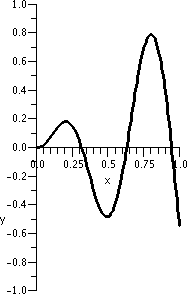 |
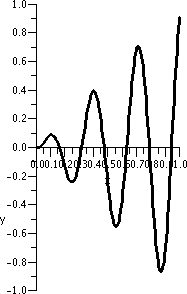 |
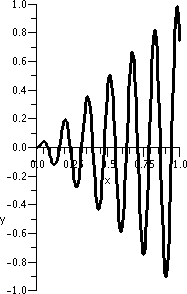 |
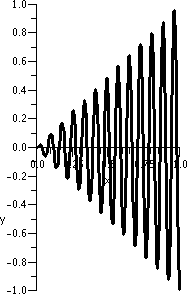 |
You should see that as n increases, the wiggling gets more and more
rapid, and the amplitude (height, both + and -) is always trapped
between x and -x (since sine is between -1 and +1). Sometimes x is
called the envelope of these curves (it is what the curves are
sort of "packaged" inside, after all). The more and more
rapid wigglings will tend to cancel each other out in the definite
integral (area below the x-axis is negative, remember!). So the
geometry tends to suggest that the net area over [0,1] goes to 0 as n
goes to infinity. The algebraic form of the answer we got,
-cos(n)/n+[sin(n)/n2], repeats this. The top in both cases
(sine and cosine of n) is something between -1 and +1, while the
bottom in both cases, goes to infinity. The result will certainly
approach 0. In the context of vibrations, where many such integrals
arise, this means there is less and less energy at high frequencies in
a certain kind of impulse. You'll see more of this later.
There's an
interesting problem of regarding the display of these curves. I can
imagine what x sin(1,000x) looks like on [0,1], but I
don't know of any display (hand-held or whatever) which will show the
graph accurately. If you are curious, you should try both on a
graphing calculator and on Maple trying
to graph some of these curves, and compare the result to what the
curves "really" are. There's sort of a conflict between the pixels and
sampling space and the actual values.
QotD
Compute  x ln(x)dx. (Again,
this is not a random silly function. I mentioned in 151 that the
integrand function occurs in studying "entropy", the amount of
information certain kinds of communication channels can carry ("binary
symmetric channels": aren't words great!).
x ln(x)dx. (Again,
this is not a random silly function. I mentioned in 151 that the
integrand function occurs in studying "entropy", the amount of
information certain kinds of communication channels can carry ("binary
symmetric channels": aren't words great!).
This integral is not too hard if you select the correct parts.
| Wednesday, January
24 | (Lecture
#3) |
|---|
QotD and clinics
- I tried to address the purpose of the QotD (Question of the
Day). There's no one purpose, but here are some candidates:
- Attendance. So I can know who comes to the lecture and who
doesn't, and perhaps, give some appropriate award to those who do.
- Feedback to me. As I mentioned, the person talking to a group of
people may sometimes not know how effective the intended communication
is. If I give what I think as a straightforward problem related to the
lecture, I may get some information about that effectiveness when I
look at the results.
- Feedback to you. Again, if the lecturer's supposedly
straightforward problem repeatedly is misunderstood or badly done by a
student, perhaps this signals the student to do more work. Feedback is
important -- communication is important in any human
relationship. Also, you can see how I grade, which might be useful in
formal exams.
- The clinics have been augmented by
another time and day (Tuesday). If you are serious about learning the
material, these form an excellent opportunity to do homework with
people who are professionally prepared and interesting in increasing
your success. Sunday, when Ms. Panova, who has a great track record
with the LRC, is working, should be especially appropriate for
students (hey, it is hard to imagine a class conflicting with the
Sunday clinic!).
Work
which is physics which is something I know little about. I have been
told that Work=Force·Distance. Also I have been told that units
matter, and the most generally used units for Distance, Force, and
Work are meters, newtons, and joules. I will use as my units feet,
pounds, and foot-pounds. Sigh. So lifting 10 pounds for 5 feet does 50
foot-pounds of work. Huh. The only thing wrong is that the
abbreviation for pound is lb.
 Pulling a chain up a cliff
Pulling a chain up a cliff
I have an iron chain which weighs 3 pounds per foot and is 100 feet
long. It hangs from the edge of a tall cliff. How much work is
required to pull the chain to the top of the cliff?
Here's a picture of the chain. (Drawing the pictures is the fun part
for me.) We can imagine the chain's length being broken up into tiny
pieces, and then we would need to lift the pieces up the cliff. Let's
see: suppose we have a piece which is x feet from the top of the
cliff, and a tiny piece of length dx is imagined there. Then the
weight of that tiny piece is 3 dx (the 3 above is actually a sort
of linear density). To lift just that piece to the top of the cliff
needs x·3 dx amount of work. But the whole chain is made
up of these pieces, and so we need to add up this amount of work, and
(due to the way I set this up) we should take the integral from the
top (x=0) to the bottom (x=100) of the chain. This will get the total
work:
 01003x dx=(3/2)x2]0100=(3/2)(100)2.
01003x dx=(3/2)x2]0100=(3/2)(100)2.
Springs
Many real world springs obey Hooke's Law over "a portion of their
elastic range". This means that the distortion of the spring from its
equilibrium length is in a direction opposite to the impressed force
and has length directly proportional to the force. This is, more or
less, "F=kx", where F is the force and x is the distortion from
equilibrium and k is a constant, frequently called the spring
constant. So twice the weight on a spring will distort it twice as
much, but you probably should not assume the same for, say, ten
thousand times as much weight. Here's a typical Hooke's law/work
problem.
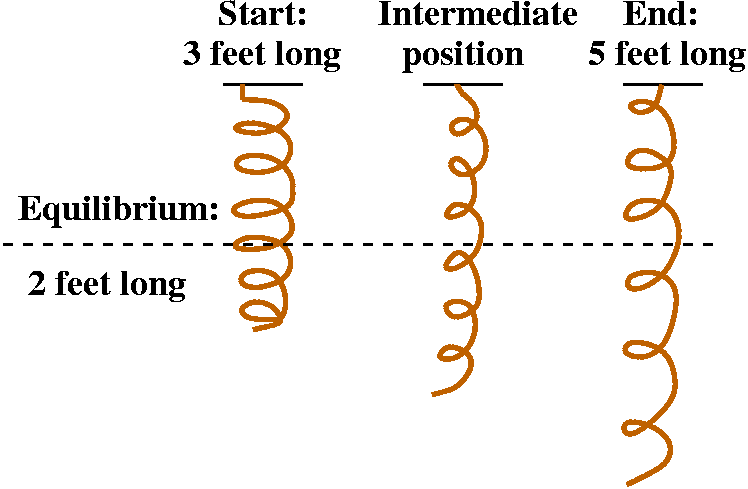 Pulling a spring
Pulling a spring
In equilibrium a spring is 2 feet long. A weight of 10 pounds
stretches it to 2.5 feet. How much work is needed to stretch the
spring from 3 feet long to 5 feet long?
Since 10 pounds changes the length of a spring by .5 feet, we know
that 10=k(.5) so that the spring constant, k, must be 20. Now consider
the various stages of the spring as it goes from the start position
(when the length is 3 and the distortion of 1) to the end position
(when the length is 5 and the distortion is 3). I'll call the
distortion, x. Perhaps we could consider an intermediate position. If
we pull the spring just a little bit more (change the length from x to
x+dx) we won't change the force very much. The force needed in that
intermediate position is 20x. The additional distance we're stretching
the spring is dx, so the "piece of work" we're doing is
20x dx. To get the total work we need to add up the pieces of
work from 3 feet long (when x=1) to 5 feet long (when x=3).
 1320x dx=10x2]13=10(32)-10(12).
1320x dx=10x2]13=10(32)-10(12).
Caution When I do these problems, an
easy mistake to make is to confuse the spring length with the
distortion from equilibrium. Hooke's law applies to the distortion, so
that is what must be considered.
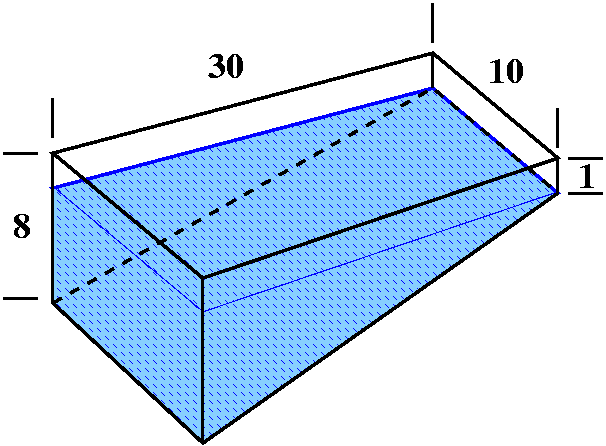 Emptying a pool
Emptying a pool
A pool has a rectangular top, 10 feet by 30 feet. The pool is 1 foot
deep at one of the edges which is 10 feet long, and is 8 feet deep at
the other edge which is 10 feet long. The depth varies linearly
between these edges. The pool is filled with water but the top of the
water level is 1 foot below the top of the pool. How much work is
needed to pump out the water in the pool (that is, to the top of the
pool?).
An oblique view of the pool is shown to the right. I hope that
this picture corresponds to what your view of the description in words
above. We need to raise the water to the top of the pool. To do this,
we need some information about the force needed (the weight of the
water).
The density of
water is about 62.5 pounds per cubic foot. One student cleverly
asked if water near the bottom of the pool would have a higher
density. Generally, of course, stuff near the bottom compresses, but
it turns out that water as rather low compressibility
and we can accept the 62.5 as valid for all of the water in the pool.
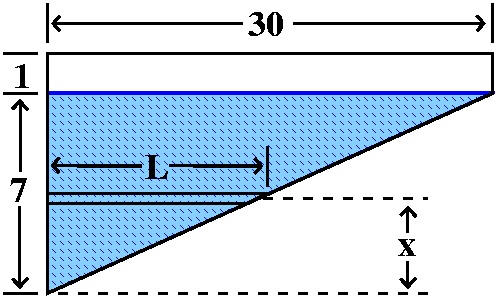 Although the lovely picture above pleases me (artistically!), a more
reasonable view might be sideways. I will put the origin of a
coordinate system for depth at the bottom of the pool (certainly there
may be one or two other reasonable places to put it). Then I will look
at a typical intermediate slice of the water volume at height x from
the bottom of the pool. The slice will have thickness dx. The reason
to look at this is that all of the water in that slice will need to be
lifted the same distance to the top of the pool. So this method of
organizing the computation allows me to put the distance into one part
of the problem, and then concentrate on the force (the weight of the
slice) in another part of the problem. But now we need to think about
the volume of the slice. It is dx thick, and I hope you can see that
the cross-section of the slice is a rectangle. It goes entirely across
the 10 foot width of the pool, and what varies in the slice is the
length, which I labeled L in the diagram. Similar triangles tell me
that L/x=30/7 so that L=(30/7)x. The volume of a slice is
(10)(30/7)x dx, so that the weight of a slice is
(62.5)(10)(30/7)x dx. This slice needs to be lifted to the top
of the pool (not just the top of the water!) and this distance is
1+(7-x)=8-x (I wrote it this way to emphasize that 7-x is the distance
to the top of the water, and 1 more foot to get to the top of the
pool). So the amount of work needed is (8-x)(62.5)(10)(30/7)x dx. To
get the total work I need to add up the work from the bottom of the
water (x=0) to the top of the water (x=7):
Although the lovely picture above pleases me (artistically!), a more
reasonable view might be sideways. I will put the origin of a
coordinate system for depth at the bottom of the pool (certainly there
may be one or two other reasonable places to put it). Then I will look
at a typical intermediate slice of the water volume at height x from
the bottom of the pool. The slice will have thickness dx. The reason
to look at this is that all of the water in that slice will need to be
lifted the same distance to the top of the pool. So this method of
organizing the computation allows me to put the distance into one part
of the problem, and then concentrate on the force (the weight of the
slice) in another part of the problem. But now we need to think about
the volume of the slice. It is dx thick, and I hope you can see that
the cross-section of the slice is a rectangle. It goes entirely across
the 10 foot width of the pool, and what varies in the slice is the
length, which I labeled L in the diagram. Similar triangles tell me
that L/x=30/7 so that L=(30/7)x. The volume of a slice is
(10)(30/7)x dx, so that the weight of a slice is
(62.5)(10)(30/7)x dx. This slice needs to be lifted to the top
of the pool (not just the top of the water!) and this distance is
1+(7-x)=8-x (I wrote it this way to emphasize that 7-x is the distance
to the top of the water, and 1 more foot to get to the top of the
pool). So the amount of work needed is (8-x)(62.5)(10)(30/7)x dx. To
get the total work I need to add up the work from the bottom of the
water (x=0) to the top of the water (x=7):
 07(8-x)(62.5)(10)(30/7)x dx=(62.5)(10)(30/7)
07(8-x)(62.5)(10)(30/7)x dx=(62.5)(10)(30/7) 078x-x2dx=(62.5)(10)(30/7)
(4x2-x3/3)]07=(62.5)(10)(30/7)(4(72)-73/3).
078x-x2dx=(62.5)(10)(30/7)
(4x2-x3/3)]07=(62.5)(10)(30/7)(4(72)-73/3).
Since I don't much care about the answer, all I said about it in class
was it would be useful to check if it were positive (otherwise
draining pools would solve the world's energy problems in a really
creative and "green" fashion). And, yeah, 4(72)=196 and
73/3=343/3, so the answer is positive.
Some comments on solutions of the work problems
The methods of solution are reasonable and the selection of problems
that I showed you was carefully structured. In the first problem (the
chain), the force was constant (3dx) and the distance varied. In the
second problem, the distance was constant (dx!) and the force
varied. In the third problem, both the distance (8-x) and the force
(the slice's weight) varied, and I organized the problem so that I
took advantage of the geometry.
Definition of the average value of a function
The average value of a function f(x) defined on an interval [a,b] is
( abf(x) dx)/(b-a).
abf(x) dx)/(b-a).
I'll discuss why this definition is reasonable but first a very simple
example.
 Example
Example
Let's compute the average value of 1/x2 on [1,4]. So:  14(1/x2)dx=-1/x]14=-1/4-(-1/1)=3/4. (That's
because 1/x2 is x-2 which has antiderivative
{1/(-1)}x-1=-1/x. The average value is 3/4 divided by 4-1=3, so the average value is 1/4.
14(1/x2)dx=-1/x]14=-1/4-(-1/1)=3/4. (That's
because 1/x2 is x-2 which has antiderivative
{1/(-1)}x-1=-1/x. The average value is 3/4 divided by 4-1=3, so the average value is 1/4.
To the right is a graph of y=1/x2 on [1,4] together with a
horizontal line, y=1/4, the average value. Does it "look" right? I
hope so.
I made an error ... In class I made an
incorrect assertion about areas which I won't repeat here, but look at
the picture: the area beneath the curve and above the line (the line
and the curve meet at x=2) is  12(1/x2)-(1/4)dx is 1/4 and
that is certainly not half of the area under the curve. So a
horizontal line at the average height does not split the area
under the curve in half.
12(1/x2)-(1/4)dx is 1/4 and
that is certainly not half of the area under the curve. So a
horizontal line at the average height does not split the area
under the curve in half.
A continuous function on an interval and its average value
The average line does intersect the curve, though, always, if
the function is continuous. This is true because a continuous
function, f, on an interval [a,b] has a max, M, and a min, m, and its
integral must be between M(b-a) and m(b-a) so the average value
(divide by b-a) must be between M and m. And the Intermediate Value
Theorem guarantees that y=f(x) must have this value at least once
somewhere in the interval.
Samples and sample means
If you model a physical process (or a computer algorithm) by f(x) for
certain values of x, say in [a,b], you might be interested in checking
the outputs or the running time or ... lots of things. So you might
sample the function f(x) on [a,b] a finite number of times:
x1, x2, ..., xn. Then you'd get
results f(x1), f(x2), ..., f(xn). You
might want to analyze these results statistically and hope that the
information you get would represent, somehow, information about "all"
of the values of f(x) on [a,b]. The average of these n outputs is
called the sample mean.
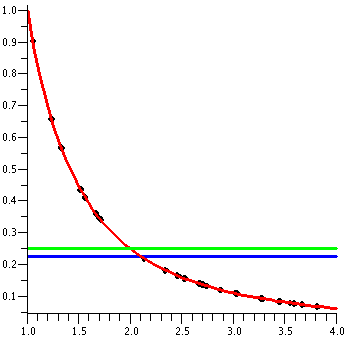 An example
An example
Maple has a fairly good "random" number
generator. That is, the properties of the generator are known and have
been investigated systematically, and they satisfy many of the
statistical criteria that are desired for randomness. I asked for 30
random numbers between 1 and 4. The list began with 1.198304612 and
continued with 1.640439652 and then with 3.984266209 ... (27 more
numbers like this!). Then I computed the mean of the values of
f(x)=1/x2 for these 30 numbers. This sample mean was
0.2241511003. Remember, the average value for f(x) on [1,4] is 1/4, or
.25. The picture to the right shows a graph of 1/x2 on
[1,4], the 30 points created, and two lines. The top line is the
average value of 1/x2 on the interval (y=.25) and the lower
line is y=the sample mean. Please realize that the picture has been
distorted (the curve previously shown is correct) so that you can see
the two lines and the sample points more clearly.
Random samples and what can be hoped ...
If we take many, many samples on [a,b], we can hope (random? What does
"random" mean?) that these samples are distributed fairly evenly over
the interval. So then look at this:
The sample mean Multiply top and bottom by b-a
and rearrange algebraically
f(x1)+f(x2)+...+f(xn) f(x1)+f(x2)+...+f(xn) (b-a)
-------------------- = ---------------------·----- =
n n (b-a)
f(x1)·[(b-a)/n]+f(x2)·[(b-a)/n]+...+f(xn)·[(b-a)/n]
--------------------------------------------------
b-aIf you now look closely at the top, I hope that you can "see" a Riemann
sum for f on [a,b]: well, at least you should see values of f at sample points, and the length of a subinterval of [a,b] when [a,b] is split up into n
equal subintervals. We can hope that almost the sample points are in
the correct subinterval.
Connection between sample means and average value
It turns out that, if the sample points are chosen uniformly at
random over the interval [a,b], then the sample means will almost
always --> the average value of the function (as defined above, with
the definite integral). To actually verify this takes some effort
because you need to understand what random and uniform and ... please
learn some probability and statistics.
Folding back on itself: how to approximate an integral
The previous result is true, and it has been used in very cute
reversed fashion. That is, one can compute sample means and then use
the sample means to estimate the definite integral. That is, if you
wanted to know the value of  abf(x) dx numerically,
approximately, take a large number of samples of f(x) in the interval
[a,b] (uniformly, randomly) and take their average. Multiply the
result by the length of the interval, b-a. The result is an
approximation to the value of the integral.
abf(x) dx numerically,
approximately, take a large number of samples of f(x) in the interval
[a,b] (uniformly, randomly) and take their average. Multiply the
result by the length of the interval, b-a. The result is an
approximation to the value of the integral.
An example
Maple has a fairly efficient (fast and
satisfies some well-known criteria for randomness) random number
"generator". I used it to try to compute the integral of x3
over the interval [5,8]. The "true value" of this integral is
867.95. Here are Monte Carlo approximations for specific "flips" (?)
or choices of random points in the interval. What I asked Maple to do is the following: select some "random"
numbers between 5 and 8, say x1, x2, ...,
xn. Then compute this sum:
x13+x23+...xn3.
Then divide this by n, and multiply by 3, the length of the
interval. The results of this experiment are below. Please realize
that if I ran this experiment another time I would likely get
different results (!).
| # of points | Reported approximation |
|---|
| 10 | 1007.29154 |
| 100 | 815.78669
|
| 1,000 | 850.26269 |
| 10,000 | 868.39938 |
| 100,000 | 867.07575 |
| 1,000,000 | 867.77362 |
| 10,000,000 | 867.66869 |
Please notice that the results "seem" to be getting closer to the true
value, but the approach is not very systematic. Actually the last
answer is more distant than the preceding one. (A possible reason is
accumulated inaccuracy because of the large numbers of floating point
arithmetic operationcs which are needed.) I would use Monte Carlo
methods only if other numerical or analytic approaches seem to be
inadvisable. We will see later in the course many methods for
computation of integrals.
Further information about the Monte Carlo
method.
QotD
I remarked that Maple had reported that
the average value of x2sqrt{4+5x3} on [0,1] was
38/45. I asked students to give convincing evidence that this was
true.
I expected the following: since 1-0=1, the value of the integral
of x2sqrt{4+5x3} on [0,1] should be 38/45. I
gave this hint: u=4+x3. With that hint and the use
of substitution we see:
du=15x2dx, so (1/15)du=x2dx and  x2sqrt{4+5x3}dx=(1/15)
x2sqrt{4+5x3}dx=(1/15) u1/2du=(1/15)(1/[3/2])u3/2+C=(2/45)(4+5x3)3/2+C.
Therefore
u1/2du=(1/15)(1/[3/2])u3/2+C=(2/45)(4+5x3)3/2+C.
Therefore  01x2sqrt{4+5x3}dx=(2/45)(4+5x3)3/2]01=(2/45)93/2-(2/45)43/2=(2·27)/45-(2·8)/45=38/45.
01x2sqrt{4+5x3}dx=(2/45)(4+5x3)3/2]01=(2/45)93/2-(2/45)43/2=(2·27)/45-(2·8)/45=38/45.
Comments Some errors were made because students assumed
that the antiderivative had to be 0 at the lower limit, where x=0. Of
course (2/45)(4+5x3)3/2 is not 0 when x=0. A
substantial number of students showed they were not able to complete
an antiderivative using the substitution method, even after being told
what the substitution was. On their papers I wrote, "Please review
substitution as done in Math 151." This is serious advice and a real
warning, since what we will do in this course (and what students need
to know) is more complicated methods of finding antiderivatives. Those
students should review by doing 5 to 10 such problems from last
semester.
| Monday, January
22 | (Lecture
#2) |
|---|
Clinics, student lists, workshops ...
The purpose of the clinics is to help
people do textbook problems and to study the course material. The
major purpose of the student lists is to
help people connect and form study groups, to help them work with the
problems in the course. The major purpose of the workshop writeups is to help students get
familiar with the demands of written technical exposition, on a small
scale.
Before ...
The volume of a general solid of revolution is discussed in the previous lecture, along with a verification of
the formula for the volume of a right circular cone.
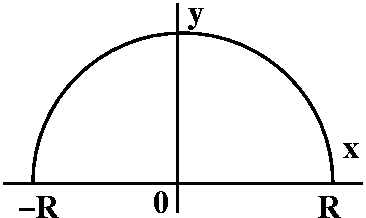 Volume of a sphere
Volume of a sphere
To get the volume of a sphere, let's choose a fairly simple profile
curve. A circle of radius R centered at the origin is
x2+y2=R2. If we solve for y, we get
y=+/-sqrt(R2-x2). We only need the upper semicircle revolved around the x-axis in order to get a whole sphere of radius R, so we just need the + sign: f(x)=sqrt(R2-x2). We will add the slices from the left, x=-R, to the right, x=R, and this should be the volume of the sphere. The general formula,  leftrightPi f(x)2dx becomes
leftrightPi f(x)2dx becomes
Pi -RR(sqrt(R2-x2))2dx
-RR(sqrt(R2-x2))2dx
and (luckily?) the square root cancels with a square, and the result can
be evaluated by FTC:
Pi -RRR2-x2dx=
Pi(R2x-(x3/3))]-RR=Pi(R3-(R3/3)-Pi(R2(-R)-((-R)3/3)). This
is (after the minus signs are correctly considered) equal to
(4/3)Pi R3, which is the textbook formula for the
volume of a sphere.
-RRR2-x2dx=
Pi(R2x-(x3/3))]-RR=Pi(R3-(R3/3)-Pi(R2(-R)-((-R)3/3)). This
is (after the minus signs are correctly considered) equal to
(4/3)Pi R3, which is the textbook formula for the
volume of a sphere.
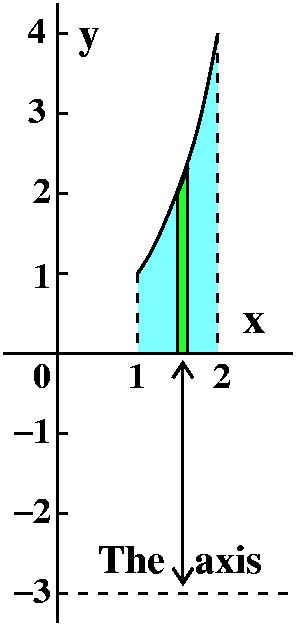
Volume of a parabolic chunk
Consider now the region in the plane bounded by y=x2, x=1
and x=2, and the x-axis. This is sort of a parabolic chunk. Suppose we
take this region and revolve it around the line y=-3. This is a line
parallel to the x-axis but three units below it. We get some sort of
weird solid. The volume of the solid can be computed with only some
slight adjustment of ideas. We slice the solid by planes perpendicular
to the axis, only now the slices will not have cross-sectional areas
which are discs or coins, but a bit more complicated.
Take a thin vertical slice of the region, a slice which is dx
thick. Then revolve that slice around the line y=-3. We'll get (with
only a little bit of lying at the edge) an object which looks like a
washer. The "official" name for the cross-sectional area, a region
between two circle which have the same center, is an
annulus. What is the area of such a region?
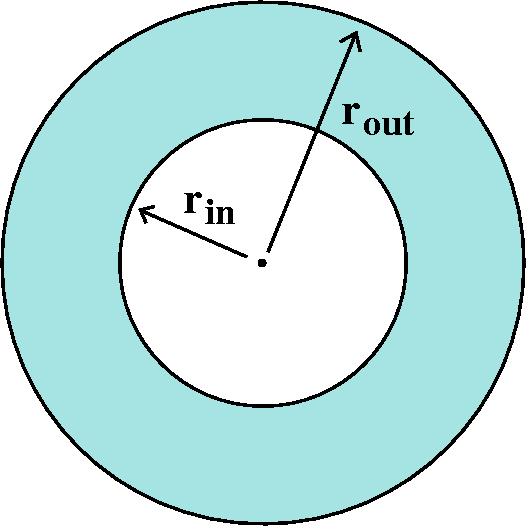 Suppose the radius of the inside, smaller circle is rin,
and the radius of the outside, larger circle is rout. The
area surrounded by the big circle is
Pi (rout)2 and the area inside the smaller
circle is Pi (rin)2. Therefore the area of
the annulus is the difference between these:
Suppose the radius of the inside, smaller circle is rin,
and the radius of the outside, larger circle is rout. The
area surrounded by the big circle is
Pi (rout)2 and the area inside the smaller
circle is Pi (rin)2. Therefore the area of
the annulus is the difference between these:
Pi (rout)2-Pi (rin)2.
In the specific case we are considering here, the outer radius is the
vertical distance from y=-3 to y=x2. This is
x2+3 or, as some people would like me to write,
x2-(-3). So rout=x2-3. And
rin is the distance from x=0 to x=-3, and this is always
3. We can get dV, a thin slice of the volume, by multiplying the area
of the annulus by the thickness, dx. The result is:
Pi (x2-3)2-Pi (3)2dx.
Please note the contents of the following information.
| An arithmetic advertisement |
|---|
(357)2=127,449
(886)2=784,996
(886)2-(357)2=657,547
| 886-357=529
(529)2=279,841
|
Notice that
(886)2-(357)2 does not equal
(886-357)2.
Parentheses are important.
|
|---|
We add up the slices from left (x=1) to right (x=2). The total volume
is V= 12Pi (x2-3)2-Pi (3>)2dx.
12Pi (x2-3)2-Pi (3>)2dx.
We can pull out the constant factor of Pi. Also,
(x2-3)2=(x2)2-2·x2·3+32=x4-6x2+9, so the 9's will cancel, and the volume we want is:
Pi 12x4-6x2dx. FTC
handles this:Pi((x5/5)-(6x3/3))]12 which is
Pi(25/5-(6·23/3))-Pi((15/5-(6·13/3)). (I'm
not going to "simplify" this!)
12x4-6x2dx. FTC
handles this:Pi((x5/5)-(6x3/3))]12 which is
Pi(25/5-(6·23/3))-Pi((15/5-(6·13/3)). (I'm
not going to "simplify" this!)
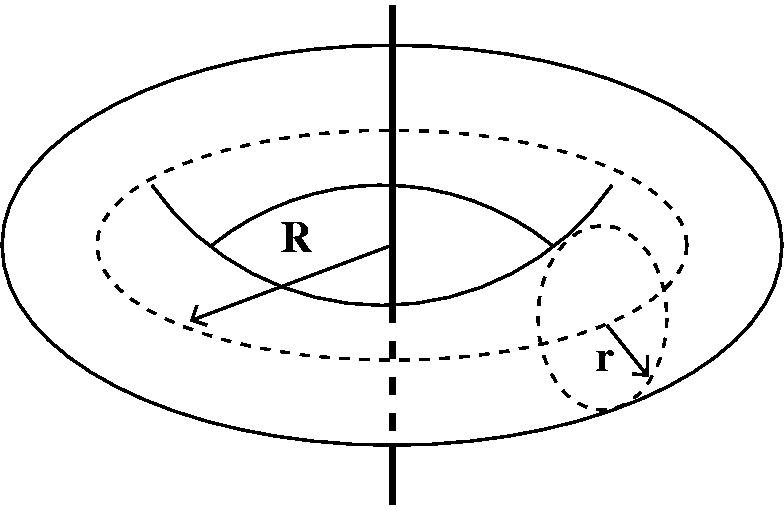 Volume of a torus
Volume of a torus
A torus (doughnut!) is a region is space which is gotten by revolving
a circle and its inside around an external line. To the right is a
picture of a torus. There's a circle of radius r, which is revolved
around an axis (a vertical line in the picture) so that the center of
the circle is at distance R from the the axis. I'd like to compute the
volume of this region. This computation is certainly not quite as
simple or toylike as the previous examples. I would like to use the
methods we've developed to compute the volume of this torus.
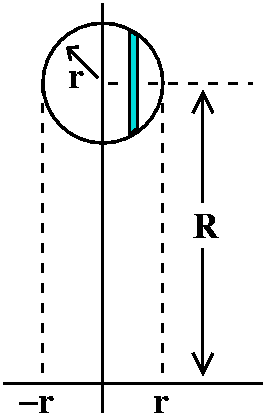 We need to get an appropriate "profile". We can use essentially any
curves we want to get the torus. Here are some choices which turn out
to make the volume quite computable. Make the x-axis be the axis of
symmetry. Create the surface of the torus by taking a circle of radius
r centered at (0,R) on the y-axis. The equation of that circle is
x2+(y-R)2=r2. If we take slices
perpendicular to the x-axis which are dx thick, then the rotated slice
is a washer. There is an inner radius, rin, and an outer
radius, rout. The piece of volume, dV, is the
cross-sectional area multiplied by the thickness. The cross-sectional
area is the difference between the areas of the circles:
Pi rout2-Pi rin2.
We need to get an appropriate "profile". We can use essentially any
curves we want to get the torus. Here are some choices which turn out
to make the volume quite computable. Make the x-axis be the axis of
symmetry. Create the surface of the torus by taking a circle of radius
r centered at (0,R) on the y-axis. The equation of that circle is
x2+(y-R)2=r2. If we take slices
perpendicular to the x-axis which are dx thick, then the rotated slice
is a washer. There is an inner radius, rin, and an outer
radius, rout. The piece of volume, dV, is the
cross-sectional area multiplied by the thickness. The cross-sectional
area is the difference between the areas of the circles:
Pi rout2-Pi rin2.
We need to find the formulas for rout and
rin. These can be gotten from the equation
x2+(y-R)2=r2: they are the values of
y which correspond, respectively, to the upper and lower
semicircles. So let's get y:
x2+(y-R)2=r2 becomes
(y-R)2=r2-x2 and
y-R=+/-sqrt{r2-x2} and finally
y=R+/-sqrt{r2-x2}.
Here the + corresponds to rout and the -
corresponds to r-. The cross-sectional area,
Pi rout2-Pi rin2,
becomes:
Pi [R+sqrt{r2-x2}]2+Pi [R-sqrt{r2-x2}]2
When some algebra is done, there are R2 terms which cancel,
and also r2-x2 terms which cancel. What remains
is (being careful of the minus signs!)
4Pi R sqrt{r2-x2}.
This formula is the cross-sectional area, and we need to multiply it
by the thickness, dx, and add up these slices from left to right in
the diagram shown. But left to right here is -r to +r. So the volume
of the torus is:
 -r+r4Pi R sqrt{r2-x2}dx.
-r+r4Pi R sqrt{r2-x2}dx.
The 4Pi R is a constant and can be pulled out of the integral
(there's no x in it!). But what remains is  -r+rsqrt{r2-x2}dx. But
now, honestly, we've got a problem. I would like to use FTC,
but (at this stage of our "technology") I don't know an antiderivative
of sqrt{r2-x2}. So we seem to be stuck.
-r+rsqrt{r2-x2}dx. But
now, honestly, we've got a problem. I would like to use FTC,
but (at this stage of our "technology") I don't know an antiderivative
of sqrt{r2-x2}. So we seem to be stuck.
A trick helps ...
But if we somehow happen to recognize a definite integral, maybe we
can "recognize" its value. And  -r+rsqrt{r2-x2}dx
represents the area "under" y=sqrt{r2-x2} as x
goes from -r to +r. But what's the curve
y=sqrt{r2-x2}? It is part of
x2+y2=r2. This is a circle of radius
r centered at the origin. And the definite integral exactly describes
the area of the upper half of that circle, so we do know its value,
half of Pi r2.
-r+rsqrt{r2-x2}dx
represents the area "under" y=sqrt{r2-x2} as x
goes from -r to +r. But what's the curve
y=sqrt{r2-x2}? It is part of
x2+y2=r2. This is a circle of radius
r centered at the origin. And the definite integral exactly describes
the area of the upper half of that circle, so we do know its value,
half of Pi r2.
Back to the volume of the torus:
It is supposed to be 4Pi R
multiplied by  -r+rsqrt{r2-x2}dx,
so the volume of the torus is
-r+rsqrt{r2-x2}dx,
so the volume of the torus is
(4Pi R)((1/2)Pi r2, or
2Pi2Rr2.
As I remarked in class, this is sort of an appropriate formula for a
volume. It multiplies three length measurements, so dimensionally the
formula is correct for a volume. It does have a strange multiplicative
constant, the 2Pi2. But even that can be explained (read
on!).
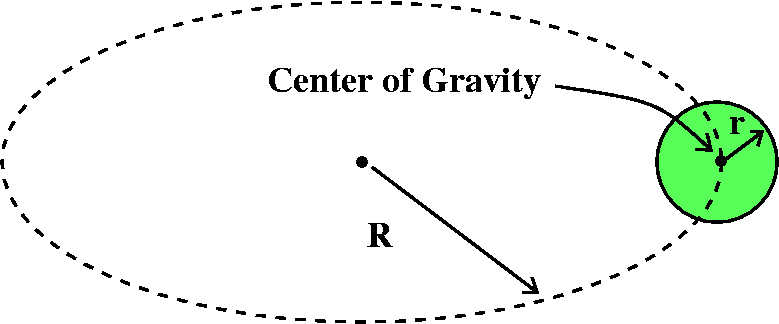 Theorem of Pappus (balancing squashing and
stretching)
Theorem of Pappus (balancing squashing and
stretching)
Here's how you could think about it. The circular disc we are
revolving about the axis "clearly" has a center of gravity at the
center of the circle. This center of gravity is being moved itself
around a circle of radius R, so the center of gravity is moving a
total distance of 2Pi R (the circumference of a circle of radius
R). The area inside the circle is Pi r2. Maybe, just
maybe, "on average", the whole volume that the circular disc sweeps
out is the are multiplied by the length that the center of gravity
moves. That's (2Pi R)(Pi r2), so this
"explanation" shows why we get the constant 2Pi2
multiplying the dimensionally appropriate Rr2.
This idea of looking at the center of gravity, and hoping that the
squashing closer to the axis of symmetry is balanced out by the
stretching farther away from the axis of symmetry, is actually correct
but is not at all clear to me. It is part of an idea called the
Theorem of Pappus. Some references can be found in this
Wikipedia article. A good explanation is better saved for a
calculus course in more than 1 dimension.
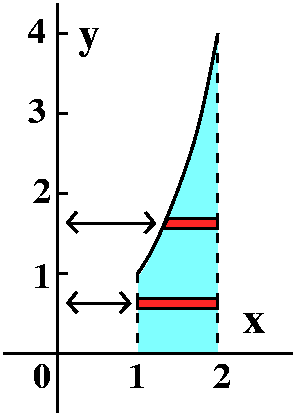 The volume of a chunk around the other way
The volume of a chunk around the other way
Suppose we take the region bounded by bounded by y=x2, x=1
and x=2, and the x-axis, which we considered earlier, and revolve it
around the y-axis. We can analyze the volume of this region by taking
slices perpendicular to the axis of symmetry, the y-axis. Now the
slices will be dy thick. We should try to write everything in terms of
y. We will now get washers in the y direction, and the integral giving the volume will be this:
 bottomtop
Pi (rout)2-Pi (rin)2dy.
bottomtop
Pi (rout)2-Pi (rin)2dy.
Well, the bottom is y=0 and the top is y=4. rout is
relatively easy: it will always be 2. But rin, which must
be written as a function of y, is more difficult. Look at the
picture. If y is between 0 and 1, rin is 1, and if y is
between 1 and 4, rin is sqrt(y) (I got this by solving for
y in the equation y=x2 and selecting the positive solution
since we're looking at the curve in the first quadrant). So rin is a piecewise function. We certainly could compute the integral, but I would have to split it into two pieces.
This seemes clumsy. Sometimes it could also be difficult or
essentially impossible -- solving a equation (finding the inverse of a
function) can be difficult. So let us see another strategy.
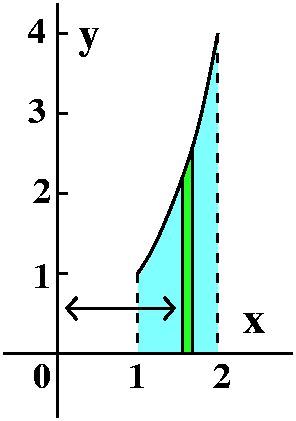
Try to slice dx!
Suppose we take a dx slice. This is a very thin vertical strip whose
distance from the y-axis is x. We could try to see what happens when
this is revolved around the y-axis, and analyze the resulting
solid. This turns out to be possible, and then the results are added
up with a definite integral.
The magic scissors
Scissors seem to
have been invented about 3500 years ago. My attempt to draw scissors
in class was met by considerable derision ("contemptuous laughter") so
I won't attempt a picture here. But the idea of the thin shell method
(well, I think of it as a ribbon) is to take the dx slice which has
height H, and revolve it around the y-axis at distance R. Then cut the
ribbon with the magic scissors, and unroll it or flatten it out (as I
mentioned in class, yes, there is certainly some distortion, and I
will address why the distortion can be neglected later in this
course). If you flatten the ribbon, the result is just about a
rectangular solid. The dimensions of the solid are inherited from the
ribbon. The thickness is dx, the height is H, and the length is
2Pi R, the circumference that the slice is moved. So the volume,
dV, that we want is 2Pi RH dx. If you go back to the
original picture with the parabola, you can see that H is
f(x)=x2. R is the distance to the y-axis, which is actually
x, sort of weird but true. Therefore we know that
dV=2Pi xf(x) dx.

Let's compute the total volume now. Well, V= leftrightdV, so:
leftrightdV, so:
V= x=1x=22Pi x(x2)dx=2Pi
x=1x=22Pi x(x2)dx=2Pi x=1x=2x3dx=2Pi(x4/4)]12=2Pi(24/4)-2Pi(14/4).
x=1x=2x3dx=2Pi(x4/4)]12=2Pi(24/4)-2Pi(14/4).
6.3: #2
In the first lecture I had enough time to do this textbook
problem. Please take a look at it. Here f(x)=sin(x2), and
the integrand for the volume of the solid involved
2Pi x sin(x2)dx. The "extra" x is just what's
needed (using the substitution u=x2) to find an
antiderivative so that FTC can be used successfully.
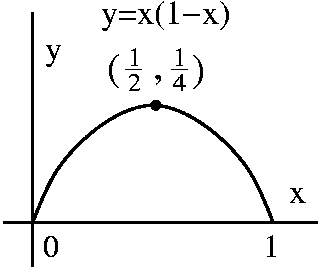 The Question of the Day (QotD)
The Question of the Day (QotD)
I draw the picture shown on the board, and asked students to answer
the following questions:
1. Write an integral for the volume which results when the region
bounded by y=x(1-x) and the x-axis is rotated around the x-axis.
I hoped that most students would answer this using the formula
V= leftrightPi f(x)2dx with
left=0 and right=1 and f(x)=x(1-x).
leftrightPi f(x)2dx with
left=0 and right=1 and f(x)=x(1-x).
Answer  01Pi (x(1-x))2dx.
01Pi (x(1-x))2dx.
2. Write an integral for the volume which results when the region
bounded by y=x(1-x) and the x-axis is rotated around the y-axis.
Here the simplest answer would use the technique and formula just
discussed.
 leftright
2Pi RH dx. Now H is x(1-x) and R is x, and left=0 and right=1.
leftright
2Pi RH dx. Now H is x(1-x) and R is x, and left=0 and right=1.
Answer  012Pi x(x(1-x))dx.
012Pi x(x(1-x))dx.
| Wednesday, January
17 | (Lecture
#1) |
|---|
A student information sheet was handed
out. The following information was on the sheet.
Student responsibilities for Math 152
-
An average of 8 hours per week outside of class studying Math 152
course material.
-
Attending every lecture and every recitation.
-
Active class participation, including asking questions when appropriate.
-
Working on the homework problems in the syllabus.
-
Careful preparation for exams, going over homework, lecture notes, and
review problems.
-
Reading appropriate sections of the textbook before and after each lecture.
|
The lecturer will support student work in the course in and out of the
classroom. There will be weekly meetings of Math
152 clinics. Students are urged to use these and all
opportunities to support their own work.
Background needed
The minimal background needed for this course is adequate knowledge of
the material of Math 151. In particular, students should know the
definitions and basic interpretations and uses of the derivative and
integral, and should be able to work with the standard functions,
knowing, where possible, their domains, ranges, graphs, derivatives,
and antiderivatives. We'll need the Fundamental Theorem of Calculus
(FTC) and the Mean Value Theorem (MVT).
What's this course about?
The previous course had some great ideas (MVT and FTC). This course
"exploits" these ideas but Warning! this
course definitely has more lengthy and intricate computations than
Math 151. An outline of the major topics of Math 152 includes the
following:
- The definite integral
The definite integral can be used to compute many interesting
quantities. Some of these include area, volume, work, pressure,
distance, center of gravity ... (parts of chapters 6, 8, and 10).
-
Computing and using the definite integral
Symbolic methods: integration by parts, partial fractions,
substitutions (chapter 7).
Numerical methods: trapezoidal rule, Simpson's
rule (chapter 7).
Differential equations and direction fields (chapter 9).
The remarks about technology on the
local information page are relevant here. Hand computations can be
elaborate.
-
Taylor's Theorem
In one variable calculus, MVT concerns the equation
f´.;(c)=[f(b)-f(a)][b-a]. After relabeling and unfolding algebra,
this becomes f(a+h)=f(a)+f´(c)h. There's also the linear
approximation idea: f(a+h) is approximately
f(a)+f´(a)h+Error. Here with graphical evidence we concluded that
the sign of the second derivative explained why the error was likely to be an
{over|under} estimate.
Taylor's Theorem includes the MVT and the linear approximation
idea. Taylor's Theorem give a local approximation of a differentiable
function by a polynomial, and also analyzes the error involved in the
approximation. This leads to "infinite series" and a new method of
describing functions (chapter 11).
Volumes by slicing: a pyramid
A pyramid has a square base which is 10 feet on each side. The peak
(vertex?) of the pyramid is 30 feet above the center of the
square. Compute the volume of the pyramid.
The approach here is to slice up the volume into simpler pieces,
approximate the pieces, add up the approximations, take the limit, and
recognize the result as a definite integral. Finally, compute the
definite integral, which in this "toy" case will be
straightforward. Here is what I did with more detail. The slices will
be taken perpendicular to the axis of symmetry, which in this case is
determined by a line segment from the center of the base square to the
vertex of the pyramid.
- Sketch the volume as well as possible.
The first picture is an oblique (tilted) view of the pyramid. Probably
more useful is the second picture shown below.
|

|
- Slice. Here I show some of the many, many, many
slices. They are very thin. I have drawn a side view, with the b axis
along one side of the base square and the h axis going from the base
to the vertex.
The slices are a little bit of h apart, so I will call the vertical
difference between them dh. I will let the notation of calculus help
me in this computation.
| 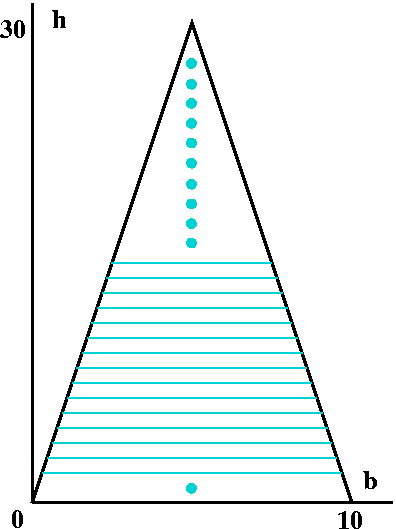 |
- Approximate the volume of a typical slice.
The first picture below attempts to be a true picture of the
slice. Notice that the edges are slightly tilted compared to the
slices. The approximation is a "rectangular parellelopiped": the
analog in three dimensions of a rectangle in the plane. The thickness
of the slice is dh, a little bit of h. The cross-sectional area is
determined by the length of the edge. Suppose that the edge has length
s. Then the volume of a slice, dV, is approximately s2dh.
|
 |
- Write a definite integral which is equal to the limit of the sum
of the approximating slices. So the total volume, V, is
 bottomtopdV
and this is
bottomtopdV
and this is
 bottomtops2dh.
bottomtops2dh.
- Compute the integral, after writing everything in terms of the
controlling variable. I use the phrase, "controlling variable", to
mean that we should convert everything we can into formulas and
information involving one variable. Here the candidate is the variable
h, mostly because of the dh. So "bottom" becomes h=0 and "top" becomes
"h=30". We need to write s in terms of h.
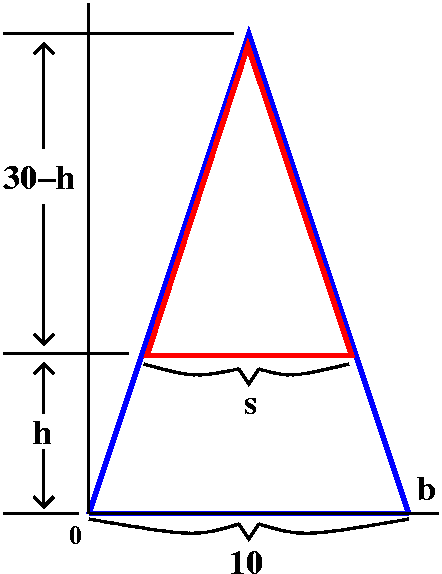
Here if we look at a side view of the pyramid, and label "everything"
I hope you will see some similar triangles. If we consider the common
ratios of height/base, then
s/[30-h]=(10)/(30) so that s=(1/3)([30-h].
As I mentioned, you can (very roughly!) check this by looking at
the "extreme" values of h. When h=0 (the bottom) then s=(1/3)(30)=10,
which is certainly true. When h=30 (the top) then s=(1/3)(0)=0,
again true.
Therefore the volume becomes:
V= bottomtops2dh=
bottomtops2dh= h=0h=30{(1/3)(30-h)}2dh.
h=0h=30{(1/3)(30-h)}2dh.
We can compute this using FTC. Probably the most elementary way
is to write
{(1/3)(30-h)}2=(1/9)(900-60h+h2). Then
antidifferentiate, and the resulting value is
(1/9){900h-(60/2)h2+(1/3)h3}]030, and the h=0
term gives us nothing, and the h=30 term gives
(1/9){900·30-(60/2)(30)2+(1/3)(30)3}
Another way to compute
 {(1/3)(30-h)}2dh is to use the substitution
u=(1/3)(30-h) so that du=-(1/3)dh and -3du=dh. Then
{(1/3)(30-h)}2dh is to use the substitution
u=(1/3)(30-h) so that du=-(1/3)dh and -3du=dh. Then
 {(1/3)(30-h)}2dh=-(1/3)
{(1/3)(30-h)}2dh=-(1/3) u2du=-(1/3){u3/3}+C=
-(1/3){((1/3)(30-h))3/3}+C. Wow!
u2du=-(1/3){u3/3}+C=
-(1/3){((1/3)(30-h))3/3}+C. Wow!
The value of the definite integral is then
-(1/3){((1/3)(30-h))3/3}]h=0h=30 and now the h=30
part gives 0 while the h=0 part is -(-(1/3){((1/3)(30))3/3}).
The two numerical results are the same! This is not at all
obvious to me.
Volumes by slicing: squares over a semicircle
A semicircular region in the xy-plane is defined by taking the inside
of a circle of radius 5 centered at the origin which is in the
half-plane with y>=0. A solid has that region as base, and the
cross-sections of the solid which are perpendicular to the x-axis are
squares, with one side of the square on the xy-plane.
Compute the volume of the solid.
Here is a picture of the base of the solid. The boundary of the base
is the "upper" half of a circle of radius 5 centered at (0,0) and a
line segment whose endpoints are (-5,0) and (5,0).
The heavy green line segment is a side
of a square perpendicular to the xy-plane and this square will be part
of the solid.
|

|
|
Here is an oblique (tilted) view of the base which also shows the
square slice by a plane perpendicular to the base. As the line
segment in the base moves from the left to the right, the square slice
changes in size, from very small to large to very small.
|

|
Now this is my attempt to "sketch" a picture of the whole solid in
space. I have tried also to show the edges of a few representative
square slices perpendicular to the x-axis.
As I mentioned in class, the volume of this solid turns out to be
quite computable even though a sketch of it is, to me, difficult. I
asked in class how many flat sides this object had and I was told that
it had two flat sides and two curvy sides. Clear? Not very ...
|
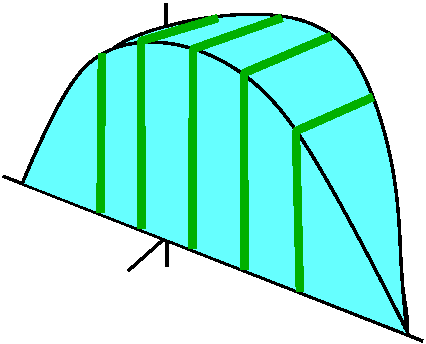
|
Computing the volume
I imagine that each slice is dx thick, and I'll call the side of the
square, s. Then the volume dV of the slice is a piece of the volume of
the solid, so dV=s2dx. And the total volume V of the solid
is the Sum of the volumes of the slices. I add up
and take a limit, and the result is a definite integral: V= leftrights2dx.
leftrights2dx.
I would like to write everything in terms of x. Well, the bounds on
the integral, left and right, are determined by the values of x, and
these are -5 and 5 (the semicircle). What about s? The semicircle is
part of a circle of radius 5 centered at (0,0), and the circle is
describe algebraically by
x2+y2=52. If you look at the first
picture of the base, you should see that the square side, s, is
actually the distance from the x-axis to the upper semicircle, and
this distance is y with y>=0. So
x2+y2=52 becomes
y2=52-x2 and
y=+/-sqrt(52-x2). We take the + sign because we
need the upper semicircle, so
s=sqrt(52-x2).
V= leftrights2dx=
leftrights2dx= x=-5x=5sqrt(52-x2)2dx.
The square root is canceled by the squaring, and we compute:
x=-5x=5sqrt(52-x2)2dx.
The square root is canceled by the squaring, and we compute:
 x=-5x=552-x2 dx=
52x-(1/3)x3]x=-5x=5=2(53-(1/3)53).
x=-5x=552-x2 dx=
52x-(1/3)x3]x=-5x=5=2(53-(1/3)53).
Unless you bribe me or we need the result in some other form, I
won't "simplify" and you may do the same. Remember, every time you
touch some piece of arithmetic, there is some chance of breaking it
and getting the wrong result. So don't touch it if you don't need
to!
Volumes by slicing: triangles over a semicircle
A semicircular region in the xy-plane is defined by taking the inside
of a circle of radius 5 centered at the origin which is in the
half-plane with y>=0. A solid has that region as base, and the
cross-sections of the solid which are perpendicular to the y-axis are
isoceles right triangles with the hypotenuse of the triangle on the xy-plane.
Compute the volume of the solid.
The base is the same region in the plane, with its boundary being
the "upper" half of a circle of radius 5 centered at (0,0) and a
line segment whose endpoints are (-5,0) and (5,0).
The heavy red line segment is a
hypotenuse of an isoceles right triangle which is perpendicular to the
xy-plane, and this triangle will be part of the solid.
|
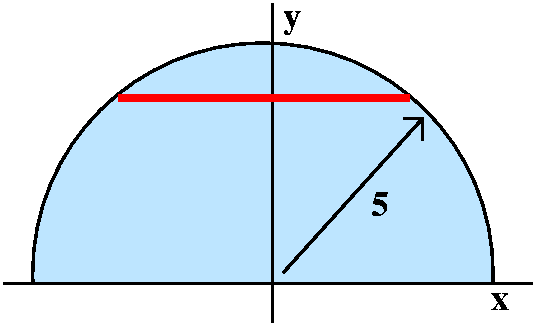
|
|
Here is an oblique (tilted) view of the base which also shows the
triangular slice by a plane perpendicular to the base. As the line
segment in the base moves from the bottom to the top, the triangular slice
changes in size, from very large (relatively!) to very small.
|
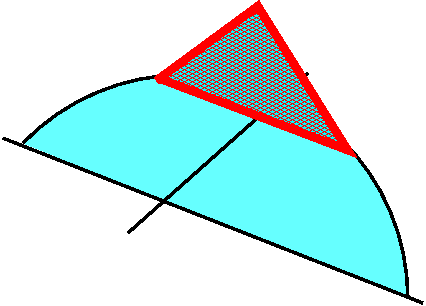
|
Now this is my attempt to "sketch" a picture of the whole solid in
space. I have tried also to show the edges of a few representative
square slices perpendicular to the x-axis.
Here's my attempt to sketch this solid. I found this solid more difficult to sketch than the previous one. Again,
the volume of this solid turns out to be quite computable. This
imaginary (?) object has two flat sides and two curvy sides. Again,
not very clear ...
|
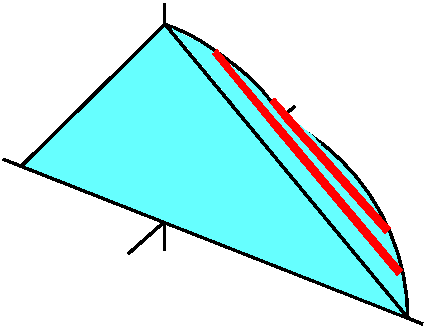
|
Computing the volume
Well, V will be a Sum of dV's, the volumes of the
slices. Each of the dV's will be the thickness, dy, multiplied by the
cross-sectional area. By the way, I did this problem in class to show
that we can integrate dy and this won't hurt too much. What is the
cross-sectional area? Here we need to think, but not too much.
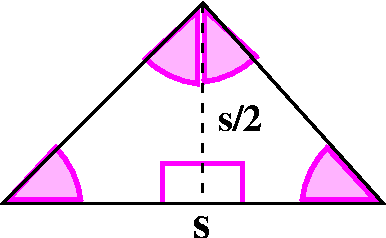 Suppose the hypotenuse of an isoceles triangle has length s, and the
hypotenuse is the base of the triangle, as shown. Then the
perpendicular line (the altitude) from the top to the base has length
s/2. This is because all of the acute angles shown are Pi/4,
45o, and so all of the triangles are also
isoceles. Therefore the area of the whole triangle, which is one-half
the base multiplied by the height, is s2/4.
Suppose the hypotenuse of an isoceles triangle has length s, and the
hypotenuse is the base of the triangle, as shown. Then the
perpendicular line (the altitude) from the top to the base has length
s/2. This is because all of the acute angles shown are Pi/4,
45o, and so all of the triangles are also
isoceles. Therefore the area of the whole triangle, which is one-half
the base multiplied by the height, is s2/4.
Now if you look back at the first picture of the semicircle in this
discussion, you should be convinced that the total volume, V, is given
by V= bottomtops2/4 dy.
bottomtops2/4 dy.
I want to write everything in terms of y. The bottom in the integral
bound corresponds to y=0 and the top in the integral bound corresponds
to y=5. What about s? In a typical slice where y is between 0 and 5, s
goes from the left side to the right side. These "sides" are
determined by x. The equation which connects x and y is again
x2+y2=52 so that
x=+/-sqrt(52-y2). But here we actually need
"both" x's, since one gives the left and one gives the right. s is
xright-xleft. And
xright=+sqrt(52-y2) and
xleft=-sqrt(52-y2), so that
s=2sqrt(52-y2). Now back to computing V.
V= y=0y=5s2/4 dy=
y=0y=5s2/4 dy= 05{2sqrt(52-y2)}2/4 dy. Miraculously
(not really) the square and square root cancel (and here so do
"22" and "/4") so that the volume is
05{2sqrt(52-y2)}2/4 dy. Miraculously
(not really) the square and square root cancel (and here so do
"22" and "/4") so that the volume is  0552-y2) dy=
52y-(1/3)y3]05=53-(1/3)53.
0552-y2) dy=
52y-(1/3)y3]05=53-(1/3)53.
Reality?
Questions could be asked about how real the shapes and solids
considered above are. I think they are very conceivable, and could
quite easily be "real". Consider the works shown of these two
architects, who are world-famous.
A view of the
Guggenheim Bilbao Museum
Architect: Frank Gehry
|
A view of the BMW Central Building in Leipzig
Architect: Zaha Hadid
|
|---|

|

|
Revolving regions to create solid objects
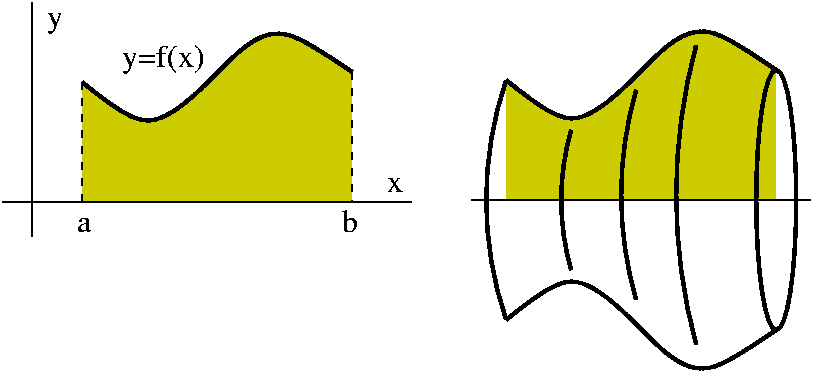 Suppose y=f(x) is a positive (or at least non-negative) function
defined on the interval [a,b]. Then the x-axis, the lines x=a and x=b,
and the part of the curve over [a,b] define a region in the plane. We
could then revolve that region around the x-axis, The resulting object
is called a solid of revolution. Such objects occur very
frequently in physical and geometric problems. Essentially any object
with an axis of symmetry comes from this solid of revolution
setup. The corresponding solid of revolution is shown far right -- a
sort of vase-shaped object. Sometimes I will call y=f(x) the
profile curve of the solid.
Suppose y=f(x) is a positive (or at least non-negative) function
defined on the interval [a,b]. Then the x-axis, the lines x=a and x=b,
and the part of the curve over [a,b] define a region in the plane. We
could then revolve that region around the x-axis, The resulting object
is called a solid of revolution. Such objects occur very
frequently in physical and geometric problems. Essentially any object
with an axis of symmetry comes from this solid of revolution
setup. The corresponding solid of revolution is shown far right -- a
sort of vase-shaped object. Sometimes I will call y=f(x) the
profile curve of the solid.
Some simple examples of solids of revolution
 Simple functions give some pictures of nice solids. A positive
constant function on an interval turns into a cylinder. A straight
line segment with one end point 0 makes a right circular cone. The
word "circular" here means that the cross sections are circles, and
the word "right" here means that the axis is perpendicular to the
cross sections. So, more precisely, the cylinder shown here is a right
circular cylinder.
Simple functions give some pictures of nice solids. A positive
constant function on an interval turns into a cylinder. A straight
line segment with one end point 0 makes a right circular cone. The
word "circular" here means that the cross sections are circles, and
the word "right" here means that the axis is perpendicular to the
cross sections. So, more precisely, the cylinder shown here is a right
circular cylinder.
|
And, of course, a semicircle which is the upper semicircle of a circle
centered on the x-axis makes a sphere.
|
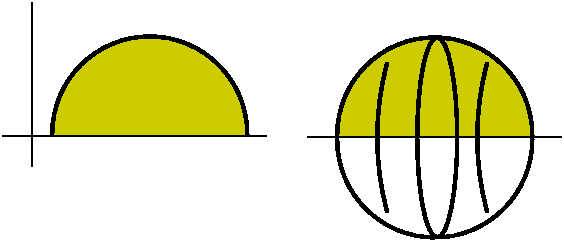
|
Volume of a solid of revolution
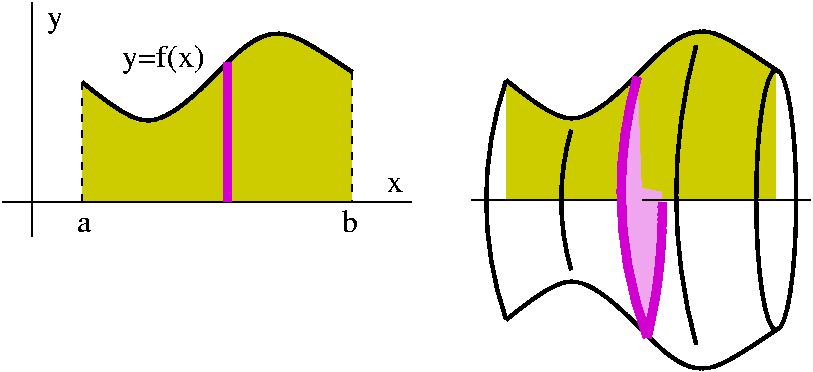 Slice the solid by planes perpendicular to the axis of symmetry. In
our setup, this is the x-axis. Imagine that the slice is dx thick, and
the radius of the cross-sectional area is r. Then dV=Pi r2dx,
and V=
Slice the solid by planes perpendicular to the axis of symmetry. In
our setup, this is the x-axis. Imagine that the slice is dx thick, and
the radius of the cross-sectional area is r. Then dV=Pi r2dx,
and V= leftrightPi r2dx=
leftrightPi r2dx= abPi f(x)2dx because the radius of the
circle is y=f(x), and left is x=a and right is x=b.
abPi f(x)2dx because the radius of the
circle is y=f(x), and left is x=a and right is x=b.
Volume of a cone
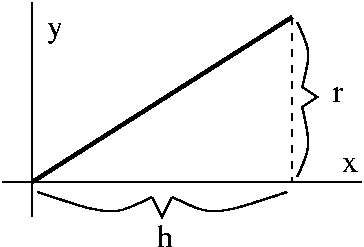 Lots of books tell me that the volume of a (right circular) cone is
Pi r2h, where r is the radius of the base of the cone
and h is the height of the cone.
Lots of books tell me that the volume of a (right circular) cone is
Pi r2h, where r is the radius of the base of the cone
and h is the height of the cone.
I think that the simplest profile curve which turns into the cone is a
line segment whose endpoints are the origin and (h,r). Therefore
f(x)=(Constant)x, and since f(h)=r, we know (Constant)h=r, so
Constant=r/h. Therefore the general formula for the volume of a solid
of revolution around the x-axis, with a profile curve f(x), which is
 abPi f(x)2dx, becomes in this case
V=
abPi f(x)2dx, becomes in this case
V= 0hPi (rx/h)2dx=
0hPi (rx/h)2dx= 0hPi r2x2/h2 dx. FTC then gives Pi r2x3/(3h2)]0h=Pi r2h3/(3h2)=(1/3)Pi r2h. The answer agrees with the formula in the books.
0hPi r2x2/h2 dx. FTC then gives Pi r2x3/(3h2)]0h=Pi r2h3/(3h2)=(1/3)Pi r2h. The answer agrees with the formula in the books.
Warning
This note is directed both to students and to me. I will try
very diligently to cover approximately the same material in the two
lectures I give each Monday and each Wednesday. The record above shows
my failure on the first day! It shows what I did in the first
lecture. In the second lecture, I did not get to the material
on solids of revolution. I am sorry, and I will try harder in the
future.
Maintained by
greenfie@math.rutgers.edu and last modified 2/17/2007.
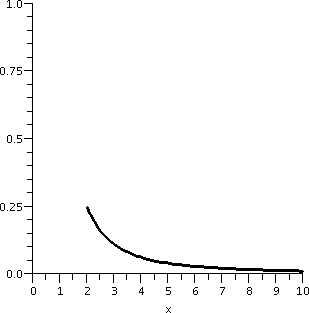 A graph, an area, and an integral: their behavior for large x
A graph, an area, and an integral: their behavior for large x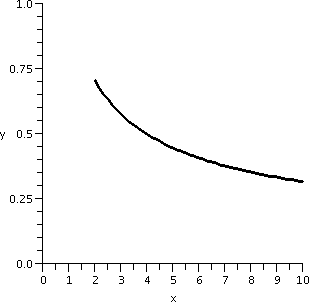 Another graph, an area, and an integral: their behavior for
large x
Another graph, an area, and an integral: their behavior for
large x Many real-life phenomena are described using something called the
exponential probability distribution. For example, the probable life-time of a lightbulb could be described with it. See
Many real-life phenomena are described using something called the
exponential probability distribution. For example, the probable life-time of a lightbulb could be described with it. See 
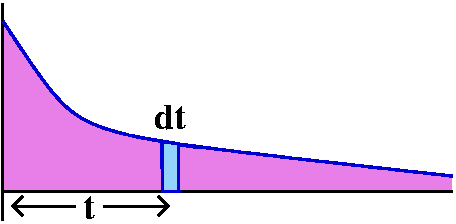

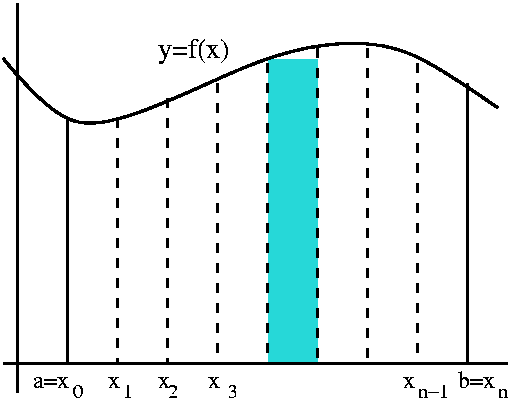
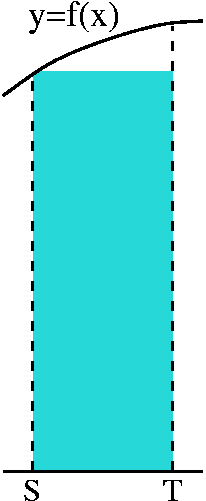 The error in one panel: weird integration by parts
The error in one panel: weird integration by parts The Trapezoid Rule
The Trapezoid Rule The picture to the right is my attempt to show such
interpolation. Again we can ask
The picture to the right is my attempt to show such
interpolation. Again we can ask
 Finding eagles
Finding eagles Geometric solution
Geometric solution
 Back to x-land
The translation back turns out to be interesting and more involved
than similar previous transactions. We know that sec(
Back to x-land
The translation back turns out to be interesting and more involved
than similar previous transactions. We know that sec( Why look at these things?
Why look at these things? Example 17
Example 17 Now when x=0,
0 arctan(0)=0 and ln(1+02)=ln(1)=0. So plugging in 0
gets us 0. Plug in 1: arctan(1)-(1/2)ln(2). Now arctan(1) can be given
in terms of tranditional constants, and it is Pi/4. And actually,
(1/2)ln(2)=ln(sqrt(2)). So the area under arctan between 0 and 1 is
Pi/4 minus the natural log of the square root of 2. This is so
... silly that it almost makes the computation worthwhile. Pi/4 is
about .78539, and ln(sqrt(2)) is about .34657, so the area seems to be
about .43882. The picture to the left is supposed to show this chunk
of arctan inside the unit square. Is about 40% of the area under the
curve? You decide.
Now when x=0,
0 arctan(0)=0 and ln(1+02)=ln(1)=0. So plugging in 0
gets us 0. Plug in 1: arctan(1)-(1/2)ln(2). Now arctan(1) can be given
in terms of tranditional constants, and it is Pi/4. And actually,
(1/2)ln(2)=ln(sqrt(2)). So the area under arctan between 0 and 1 is
Pi/4 minus the natural log of the square root of 2. This is so
... silly that it almost makes the computation worthwhile. Pi/4 is
about .78539, and ln(sqrt(2)) is about .34657, so the area seems to be
about .43882. The picture to the left is supposed to show this chunk
of arctan inside the unit square. Is about 40% of the area under the
curve? You decide.




 Pulling a chain up a cliff
Pulling a chain up a cliff Pulling a spring
Pulling a spring Emptying a pool
Emptying a pool Although the lovely picture above pleases me (artistically!), a more
reasonable view might be sideways. I will put the origin of a
coordinate system for depth at the bottom of the pool (certainly there
may be one or two other reasonable places to put it). Then I will look
at a typical intermediate slice of the water volume at height x from
the bottom of the pool. The slice will have thickness dx. The reason
to look at this is that all of the water in that slice will need to be
lifted the same distance to the top of the pool. So this method of
organizing the computation allows me to put the distance into one part
of the problem, and then concentrate on the force (the weight of the
slice) in another part of the problem. But now we need to think about
the volume of the slice. It is dx thick, and I hope you can see that
the cross-section of the slice is a rectangle. It goes entirely across
the 10 foot width of the pool, and what varies in the slice is the
length, which I labeled L in the diagram. Similar triangles tell me
that L/x=30/7 so that L=(30/7)x. The volume of a slice is
(10)(30/7)x dx, so that the weight of a slice is
(62.5)(10)(30/7)x dx. This slice needs to be lifted to the top
of the pool (not just the top of the water!) and this distance is
1+(7-x)=8-x (I wrote it this way to emphasize that 7-x is the distance
to the top of the water, and 1 more foot to get to the top of the
pool). So the amount of work needed is (8-x)(62.5)(10)(30/7)x dx. To
get the total work I need to add up the work from the bottom of the
water (x=0) to the top of the water (x=7):
Although the lovely picture above pleases me (artistically!), a more
reasonable view might be sideways. I will put the origin of a
coordinate system for depth at the bottom of the pool (certainly there
may be one or two other reasonable places to put it). Then I will look
at a typical intermediate slice of the water volume at height x from
the bottom of the pool. The slice will have thickness dx. The reason
to look at this is that all of the water in that slice will need to be
lifted the same distance to the top of the pool. So this method of
organizing the computation allows me to put the distance into one part
of the problem, and then concentrate on the force (the weight of the
slice) in another part of the problem. But now we need to think about
the volume of the slice. It is dx thick, and I hope you can see that
the cross-section of the slice is a rectangle. It goes entirely across
the 10 foot width of the pool, and what varies in the slice is the
length, which I labeled L in the diagram. Similar triangles tell me
that L/x=30/7 so that L=(30/7)x. The volume of a slice is
(10)(30/7)x dx, so that the weight of a slice is
(62.5)(10)(30/7)x dx. This slice needs to be lifted to the top
of the pool (not just the top of the water!) and this distance is
1+(7-x)=8-x (I wrote it this way to emphasize that 7-x is the distance
to the top of the water, and 1 more foot to get to the top of the
pool). So the amount of work needed is (8-x)(62.5)(10)(30/7)x dx. To
get the total work I need to add up the work from the bottom of the
water (x=0) to the top of the water (x=7): Example
Example An example
An example Volume of a sphere
Volume of a sphere
 Suppose the radius of the inside, smaller circle is rin,
and the radius of the outside, larger circle is rout. The
area surrounded by the big circle is
Pi (rout)2 and the area inside the smaller
circle is Pi (rin)2. Therefore the area of
the annulus is the difference between these:
Suppose the radius of the inside, smaller circle is rin,
and the radius of the outside, larger circle is rout. The
area surrounded by the big circle is
Pi (rout)2 and the area inside the smaller
circle is Pi (rin)2. Therefore the area of
the annulus is the difference between these: Volume of a torus
Volume of a torus We need to get an appropriate "profile". We can use essentially any
curves we want to get the torus. Here are some choices which turn out
to make the volume quite computable. Make the x-axis be the axis of
symmetry. Create the surface of the torus by taking a circle of radius
r centered at (0,R) on the y-axis. The equation of that circle is
x2+(y-R)2=r2. If we take slices
perpendicular to the x-axis which are dx thick, then the rotated slice
is a washer. There is an inner radius, rin, and an outer
radius, rout. The piece of volume, dV, is the
cross-sectional area multiplied by the thickness. The cross-sectional
area is the difference between the areas of the circles:
Pi rout2-Pi rin2.
We need to get an appropriate "profile". We can use essentially any
curves we want to get the torus. Here are some choices which turn out
to make the volume quite computable. Make the x-axis be the axis of
symmetry. Create the surface of the torus by taking a circle of radius
r centered at (0,R) on the y-axis. The equation of that circle is
x2+(y-R)2=r2. If we take slices
perpendicular to the x-axis which are dx thick, then the rotated slice
is a washer. There is an inner radius, rin, and an outer
radius, rout. The piece of volume, dV, is the
cross-sectional area multiplied by the thickness. The cross-sectional
area is the difference between the areas of the circles:
Pi rout2-Pi rin2.
 Theorem of Pappus (balancing squashing and
stretching)
Theorem of Pappus (balancing squashing and
stretching) The volume of a chunk around the other way
The volume of a chunk around the other way

 The Question of the Day (QotD)
The Question of the Day (QotD)









 Suppose the hypotenuse of an isoceles triangle has length s, and the
hypotenuse is the base of the triangle, as shown. Then the
perpendicular line (the altitude) from the top to the base has length
s/2. This is because all of the acute angles shown are Pi/4,
45o, and so all of the triangles are also
isoceles. Therefore the area of the whole triangle, which is one-half
the base multiplied by the height, is s2/4.
Suppose the hypotenuse of an isoceles triangle has length s, and the
hypotenuse is the base of the triangle, as shown. Then the
perpendicular line (the altitude) from the top to the base has length
s/2. This is because all of the acute angles shown are Pi/4,
45o, and so all of the triangles are also
isoceles. Therefore the area of the whole triangle, which is one-half
the base multiplied by the height, is s2/4.


 Suppose y=f(x) is a positive (or at least non-negative) function
defined on the interval [a,b]. Then the x-axis, the lines x=a and x=b,
and the part of the curve over [a,b] define a region in the plane. We
could then revolve that region around the x-axis, The resulting object
is called a solid of revolution. Such objects occur very
frequently in physical and geometric problems. Essentially any object
with an axis of symmetry comes from this solid of revolution
setup. The corresponding solid of revolution is shown far right -- a
sort of vase-shaped object. Sometimes I will call y=f(x) the
profile curve of the solid.
Suppose y=f(x) is a positive (or at least non-negative) function
defined on the interval [a,b]. Then the x-axis, the lines x=a and x=b,
and the part of the curve over [a,b] define a region in the plane. We
could then revolve that region around the x-axis, The resulting object
is called a solid of revolution. Such objects occur very
frequently in physical and geometric problems. Essentially any object
with an axis of symmetry comes from this solid of revolution
setup. The corresponding solid of revolution is shown far right -- a
sort of vase-shaped object. Sometimes I will call y=f(x) the
profile curve of the solid.
 Simple functions give some pictures of nice solids. A positive
constant function on an interval turns into a cylinder. A straight
line segment with one end point 0 makes a right circular cone. The
word "circular" here means that the cross sections are circles, and
the word "right" here means that the axis is perpendicular to the
cross sections. So, more precisely, the cylinder shown here is a right
circular cylinder.
Simple functions give some pictures of nice solids. A positive
constant function on an interval turns into a cylinder. A straight
line segment with one end point 0 makes a right circular cone. The
word "circular" here means that the cross sections are circles, and
the word "right" here means that the axis is perpendicular to the
cross sections. So, more precisely, the cylinder shown here is a right
circular cylinder.

 Slice the solid by planes perpendicular to the axis of symmetry. In
our setup, this is the x-axis. Imagine that the slice is dx thick, and
the radius of the cross-sectional area is r. Then dV=Pi r2dx,
and V=
Slice the solid by planes perpendicular to the axis of symmetry. In
our setup, this is the x-axis. Imagine that the slice is dx thick, and
the radius of the cross-sectional area is r. Then dV=Pi r2dx,
and V= Lots of books tell me that the volume of a (right circular) cone is
Pi r2h, where r is the radius of the base of the cone
and h is the height of the cone.
Lots of books tell me that the volume of a (right circular) cone is
Pi r2h, where r is the radius of the base of the cone
and h is the height of the cone.